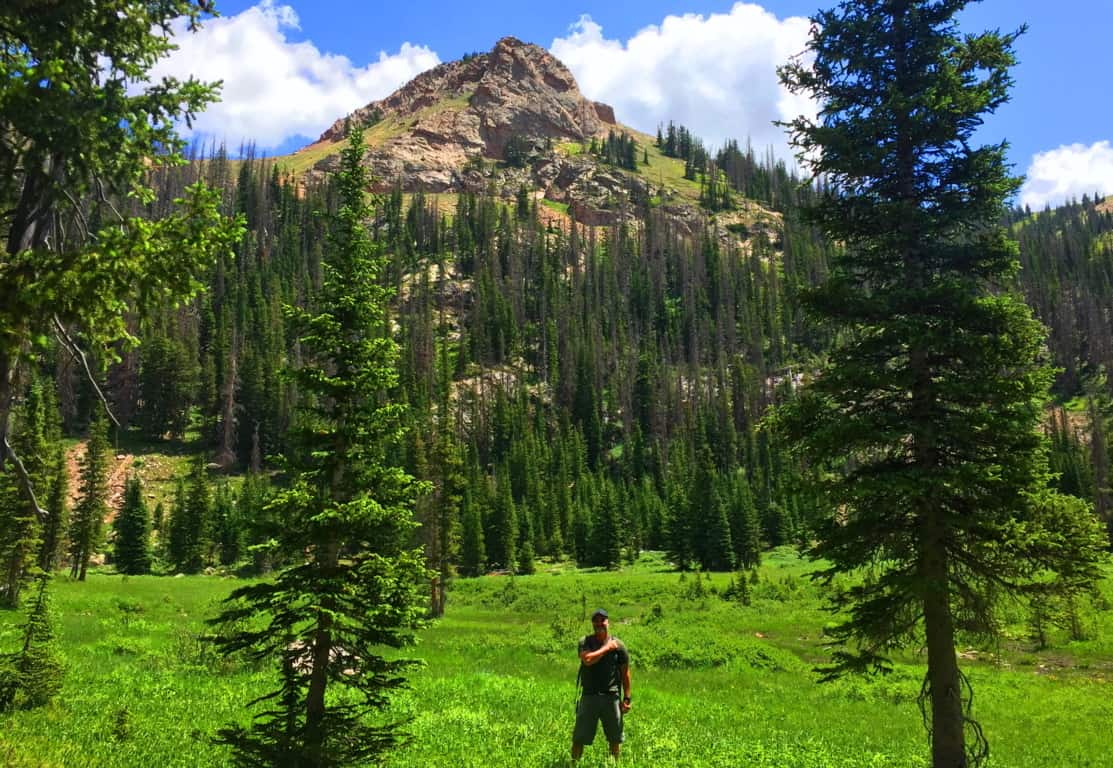Black Hills National Forest
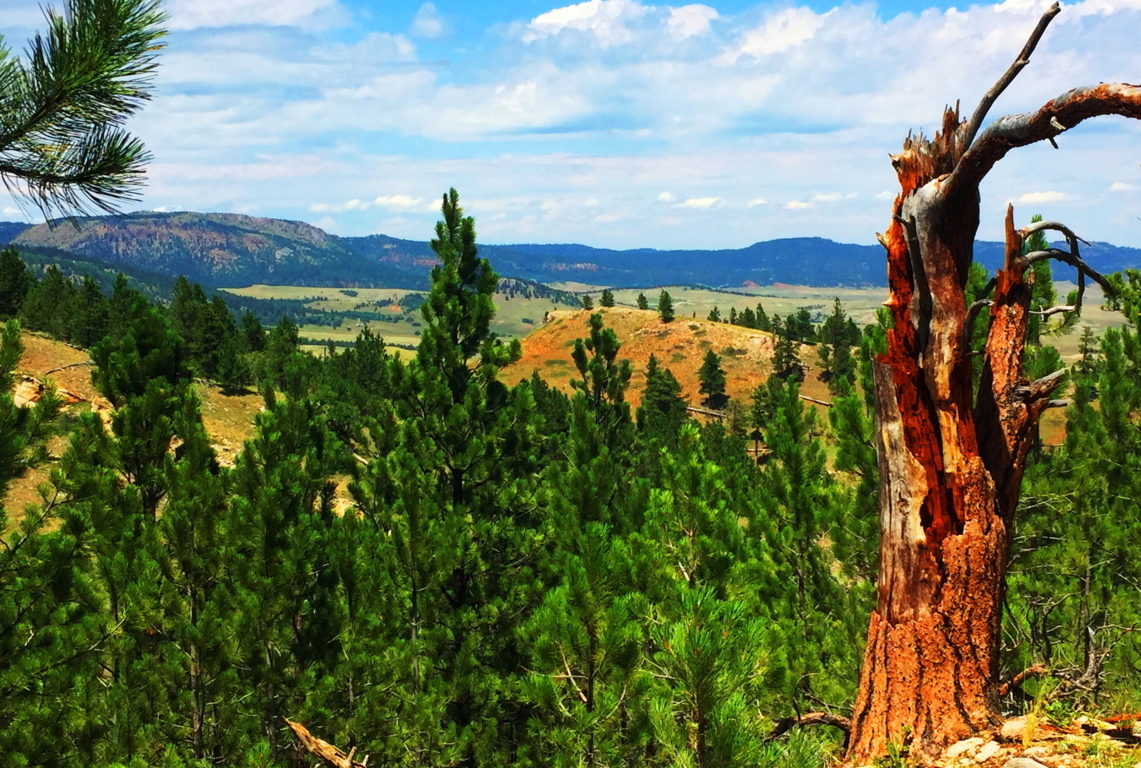
Location: Sundance, Wyoming/USA
Elevation: 3,100 ft
Prominence: 1200 ft
Note: Before you begin reading I already know what you’re thinking: “What could possibly be exciting about Wyoming? (yawn)” It’s a fair question, and something that should be addressed straight-away. The answer might surprise you a little. The truth is, the answer is totally related to what kind of hiker you are, and somewhat philosophical. You have to ask yourself: “Am I a trailblazing, stone-kicking, seeker of sacred zones in the misty heights?” “A geared-up ‘earthbound-astronaut-in-boots’ made for 10,000 feet above sea-level?” “Am I wading waist-deep in the Irish-muck to get to the distant hill where the Dolmen sits?” “Am I willing to go to that way-out-there place which others dismiss as too inconvenient?” In other words, are you passionate about breaking the domesticated spell of post-modern life? Or…are you the needy type? Do you need attention and noise? Are you in the habit of speaking constantly, needing to hear about this, that, and the other thing from the social-media feed? Do you need lots of stuff at your disposal? Do you need to be close to a metropolis and all its accoutrements? Do you need a constant phone/computer signal? If so, you’re not alone; but let’s put distant, hard to reach, places into perspective;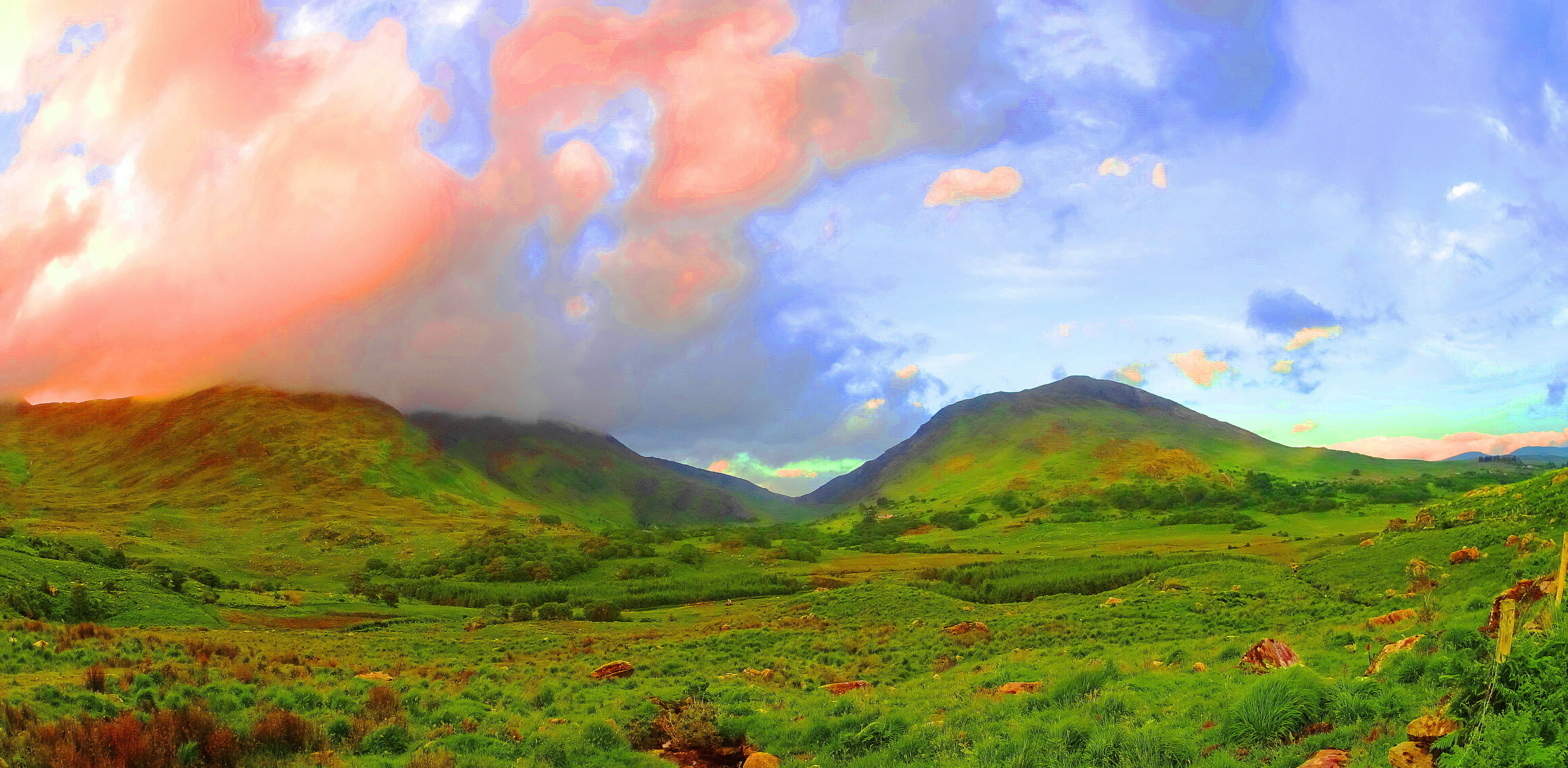 If, for example, you were to show up in a place like Killarney Ireland (Image/Left) with this needy attitude, a Killarney which is a darkly magical, mostly wet, Celtic wilderness of eternal greenery, you could perhaps say the same needy things you say of Wyoming, like: “Oh man, it’s just farms and mountains without a soul in sight”… etc etc etc. And with this needy attitude you will have already failed. You might as well go on a cruise and do the thing where you get off the boat, and then back on, after looking at a mountain from the beach, for about ten minutes. Awful. The point is this: the only real difference between the stellar beauty of a romantic wilderness like Killarney, and the lessor known wilderness of The Black Hills (Image/Below), is only the basics of fauna of the landscapes, and that’s it.
If, for example, you were to show up in a place like Killarney Ireland (Image/Left) with this needy attitude, a Killarney which is a darkly magical, mostly wet, Celtic wilderness of eternal greenery, you could perhaps say the same needy things you say of Wyoming, like: “Oh man, it’s just farms and mountains without a soul in sight”… etc etc etc. And with this needy attitude you will have already failed. You might as well go on a cruise and do the thing where you get off the boat, and then back on, after looking at a mountain from the beach, for about ten minutes. Awful. The point is this: the only real difference between the stellar beauty of a romantic wilderness like Killarney, and the lessor known wilderness of The Black Hills (Image/Below), is only the basics of fauna of the landscapes, and that’s it.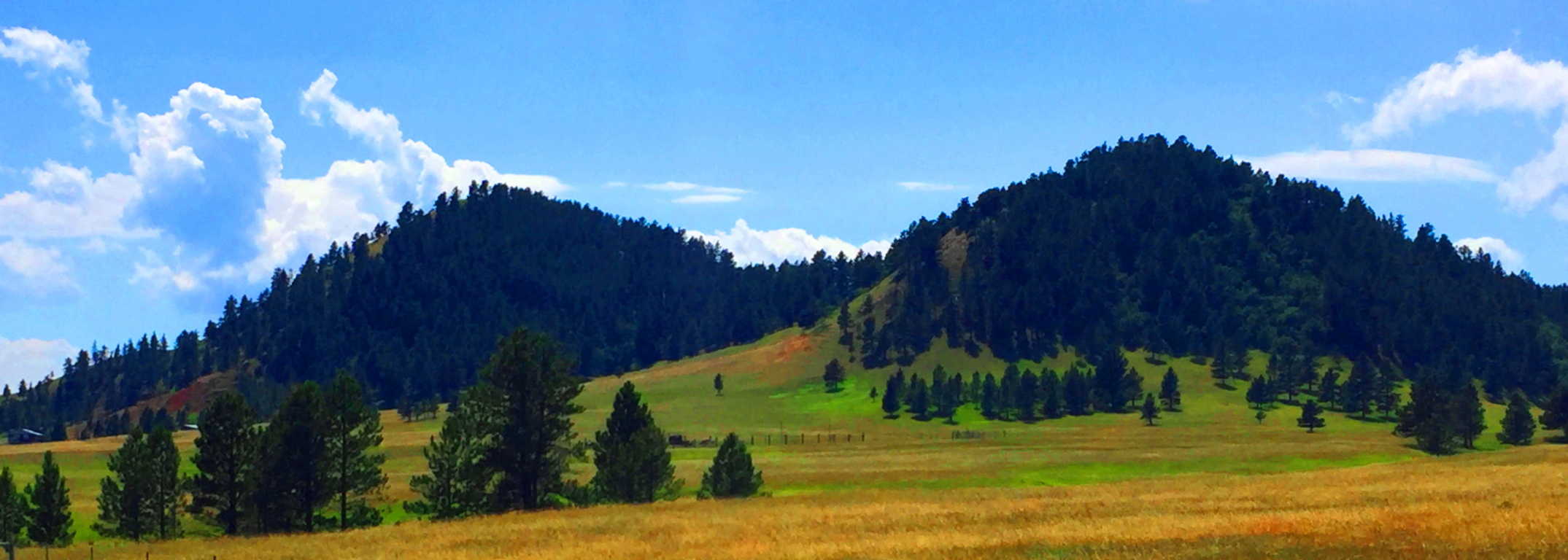 That’s all. The potential for wonder and exploration is just as possible in Wyoming as it is anywhere else on Earth. Both are haunting and spacious, eccentrically-far from any city, and soooo quiet that they are equally capable of making you face that illusive, money-bound, noise factory, you currently know as…. yourself. The Black Hills in Wyoming is yet another dream-scape that can heal your senses and sooth your thoughts. There are romantic signs in the mountains of a history that goes right back to the primordial beginning of Time, just like Celtic sites. If you open your eyes in this way, Black Hills Wyoming is a vast mystical zone, just waiting to embrace you.
That’s all. The potential for wonder and exploration is just as possible in Wyoming as it is anywhere else on Earth. Both are haunting and spacious, eccentrically-far from any city, and soooo quiet that they are equally capable of making you face that illusive, money-bound, noise factory, you currently know as…. yourself. The Black Hills in Wyoming is yet another dream-scape that can heal your senses and sooth your thoughts. There are romantic signs in the mountains of a history that goes right back to the primordial beginning of Time, just like Celtic sites. If you open your eyes in this way, Black Hills Wyoming is a vast mystical zone, just waiting to embrace you.  In American modern cinema, in films such as ‘Dances With Wolves’, ‘The Last of The Mohicans”, or “The Revanent”, there is an image of the “spiritually in-tune” Native American. This image of the stoic, quiet minded, spiritually animated native, is not easily grasped by the domesticated culture we now find ourselves in, where almost 65% of the population has now been forced to inhabit cities. It is hard to comprehend the once spiritual state of the Native American in such a postmodern situation. But, if cities are the mechanism for our domestication, than places like Black Hills National Forest in Wyoming, are the mechanism for cosmic-quiet, and a confident solitude that the Native Americans once knew. When you enter them, the quiet is practically a persona to be interacted with, not just a lack of meaningless bustle and monotonous motion. You can truly realize this in this absolutely vast space, and slightly hypnotizing slopes of the Black Hills.
In American modern cinema, in films such as ‘Dances With Wolves’, ‘The Last of The Mohicans”, or “The Revanent”, there is an image of the “spiritually in-tune” Native American. This image of the stoic, quiet minded, spiritually animated native, is not easily grasped by the domesticated culture we now find ourselves in, where almost 65% of the population has now been forced to inhabit cities. It is hard to comprehend the once spiritual state of the Native American in such a postmodern situation. But, if cities are the mechanism for our domestication, than places like Black Hills National Forest in Wyoming, are the mechanism for cosmic-quiet, and a confident solitude that the Native Americans once knew. When you enter them, the quiet is practically a persona to be interacted with, not just a lack of meaningless bustle and monotonous motion. You can truly realize this in this absolutely vast space, and slightly hypnotizing slopes of the Black Hills.
Even the image of this wide-open landscape can’t do the actual scale justice. South of this place, the Wyoming Plain rolls like an intermediary dimension between Heaven and Hell, neither rising nor falling, just continuing into an ever distant blue horizon. Some History: Obviously no Roman Army ever traversed this place, like in England or France, although, I have to think that the Caesars would have been tempted by the idea of crossing such a vast stretch of accessible land, like when they penetrated the high Plains of Scotland, where they were eventually turned back by the Picti (Scottish Natives). So, who did walk in this place in Wyoming? The Arapaho, Cheyenne, Ute, and Shoshone all inhabited this vast space as warrior-hunters of the Plains. We now know that most of their ancestors wandered over the land-bridge while hunting animals from the East-Eurasian Continent to what is now Alaska, created by the receding Ice-Age some 40,000 years ago. Once upon a time, this Plain was inundated with Buffalo, an animal by which nearly every human need can be resourced. The native tribes, amazingly, say that they were NOT the first to inhabit this place, but rather, the ancient myths tell of a race of “Celtic looking (caucasion) red-haired giants” who were already here when the natives arrived. Strangely enough, the Native Israelite tribes encountered the exact same thing when they entered Israel from Arabia, discovering giants in the hills, which is recorded in Semetic Scripture: ‘Numbers 13:32’. The Mayan and Inca say the very same thing. The megaliths of South America were there BEFORE THEY ARRIVED. In fact, nearly every Native American tribe has stories of giants controlling the heights of the mountains and hills. And these are the oldest stories that the tribes have to offer, which are now faded into inaccuracy and mere myth, due to the genocide that came for the natives in the modern Era. Like the native Scottish Picti tribes, these Native Americans were at-one with the landscape, and also like the Picti, when a foreign army came marching through, they decided to paint themselves for battle, and fight. Of-course it wasn’t the Roman Army which wandered into the heights of Wyoming, but The Union Army, a far more advanced and devastating force, and we know how that story ends. Don’t let this wide-open space and silence fool you; although it is profoundly peaceful there are mysteries and epic events which took place here, making it that much more haunting in the heights of the trail. The natives called this place “The Black Hills”, although I am not entirely sure how they could have…
Some History: Obviously no Roman Army ever traversed this place, like in England or France, although, I have to think that the Caesars would have been tempted by the idea of crossing such a vast stretch of accessible land, like when they penetrated the high Plains of Scotland, where they were eventually turned back by the Picti (Scottish Natives). So, who did walk in this place in Wyoming? The Arapaho, Cheyenne, Ute, and Shoshone all inhabited this vast space as warrior-hunters of the Plains. We now know that most of their ancestors wandered over the land-bridge while hunting animals from the East-Eurasian Continent to what is now Alaska, created by the receding Ice-Age some 40,000 years ago. Once upon a time, this Plain was inundated with Buffalo, an animal by which nearly every human need can be resourced. The native tribes, amazingly, say that they were NOT the first to inhabit this place, but rather, the ancient myths tell of a race of “Celtic looking (caucasion) red-haired giants” who were already here when the natives arrived. Strangely enough, the Native Israelite tribes encountered the exact same thing when they entered Israel from Arabia, discovering giants in the hills, which is recorded in Semetic Scripture: ‘Numbers 13:32’. The Mayan and Inca say the very same thing. The megaliths of South America were there BEFORE THEY ARRIVED. In fact, nearly every Native American tribe has stories of giants controlling the heights of the mountains and hills. And these are the oldest stories that the tribes have to offer, which are now faded into inaccuracy and mere myth, due to the genocide that came for the natives in the modern Era. Like the native Scottish Picti tribes, these Native Americans were at-one with the landscape, and also like the Picti, when a foreign army came marching through, they decided to paint themselves for battle, and fight. Of-course it wasn’t the Roman Army which wandered into the heights of Wyoming, but The Union Army, a far more advanced and devastating force, and we know how that story ends. Don’t let this wide-open space and silence fool you; although it is profoundly peaceful there are mysteries and epic events which took place here, making it that much more haunting in the heights of the trail. The natives called this place “The Black Hills”, although I am not entirely sure how they could have…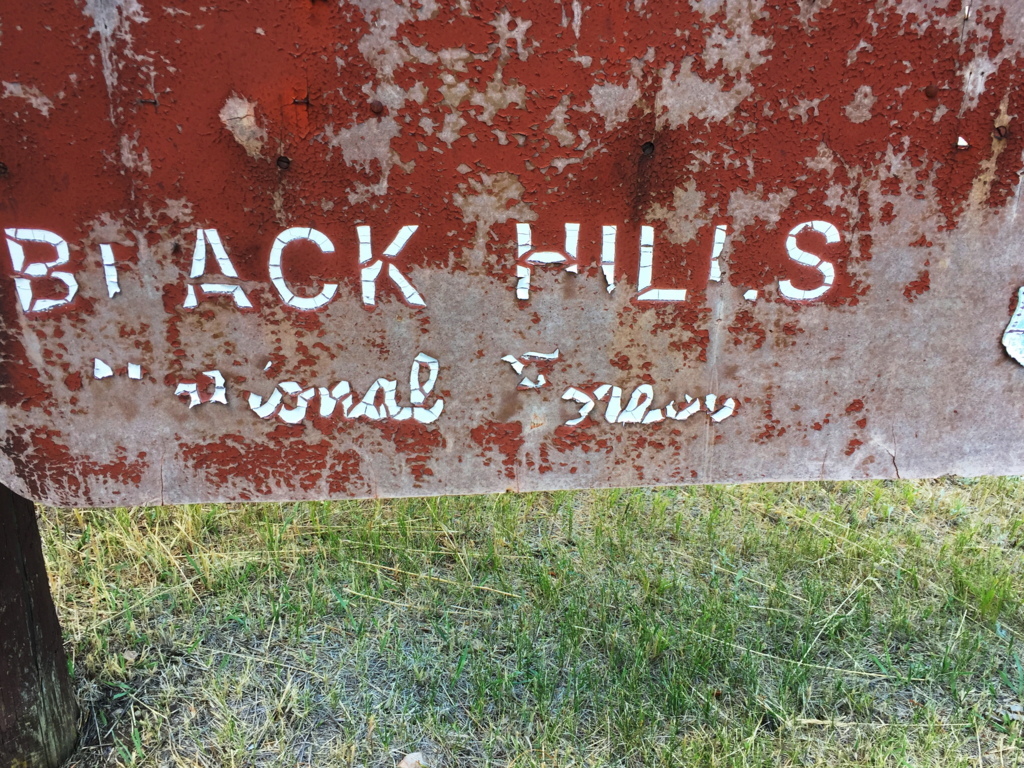 The scene is a dry green and golden haze that embeds striking patches of massive trees and knolls. It all booms-out over the region as if it never ends. The trails are not what you would call ‘a going concern’, but are still marked by the classic cursive lettering and soil-brown signs that were erected at the turn of the century. I’ve waited my entire life to see one of these particular types of signs; seeing one means you’re in the Great North West of America; a rock-star zone for hikers. This is the listed trail-head for the Black Hills, down a lulling farm-road, about 7 miles from the classically Americana town of Sundance Wyoming, population 1,182. Sundance has veterans who died for the United States memorialized in the center of Town, along with home-like breakfast parlors and ice-cream shops straight out of a Norman Rockwell painting. But these people aren’t lost to the Times, as you might ignorantly assume; they are a deeply rustic, tough, and caring people who look you straight in the eye, and extend a helping hand in a moments notice.
The scene is a dry green and golden haze that embeds striking patches of massive trees and knolls. It all booms-out over the region as if it never ends. The trails are not what you would call ‘a going concern’, but are still marked by the classic cursive lettering and soil-brown signs that were erected at the turn of the century. I’ve waited my entire life to see one of these particular types of signs; seeing one means you’re in the Great North West of America; a rock-star zone for hikers. This is the listed trail-head for the Black Hills, down a lulling farm-road, about 7 miles from the classically Americana town of Sundance Wyoming, population 1,182. Sundance has veterans who died for the United States memorialized in the center of Town, along with home-like breakfast parlors and ice-cream shops straight out of a Norman Rockwell painting. But these people aren’t lost to the Times, as you might ignorantly assume; they are a deeply rustic, tough, and caring people who look you straight in the eye, and extend a helping hand in a moments notice. 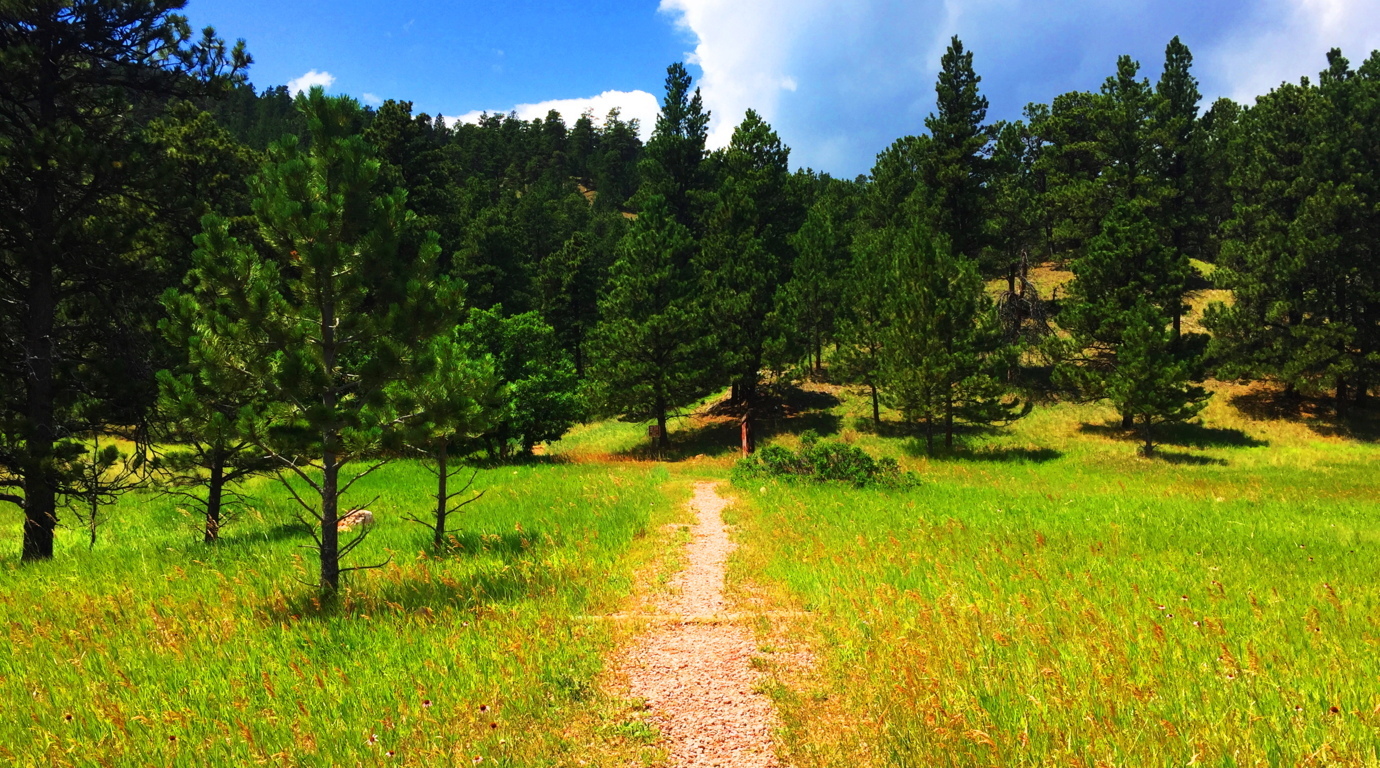 Black Hills Trail: Entering this trail is as pleasant as it gets. There are distinct and clear heights in front of you, with a breeze and swaying grass beneath spaciously assorted Pines.
Black Hills Trail: Entering this trail is as pleasant as it gets. There are distinct and clear heights in front of you, with a breeze and swaying grass beneath spaciously assorted Pines.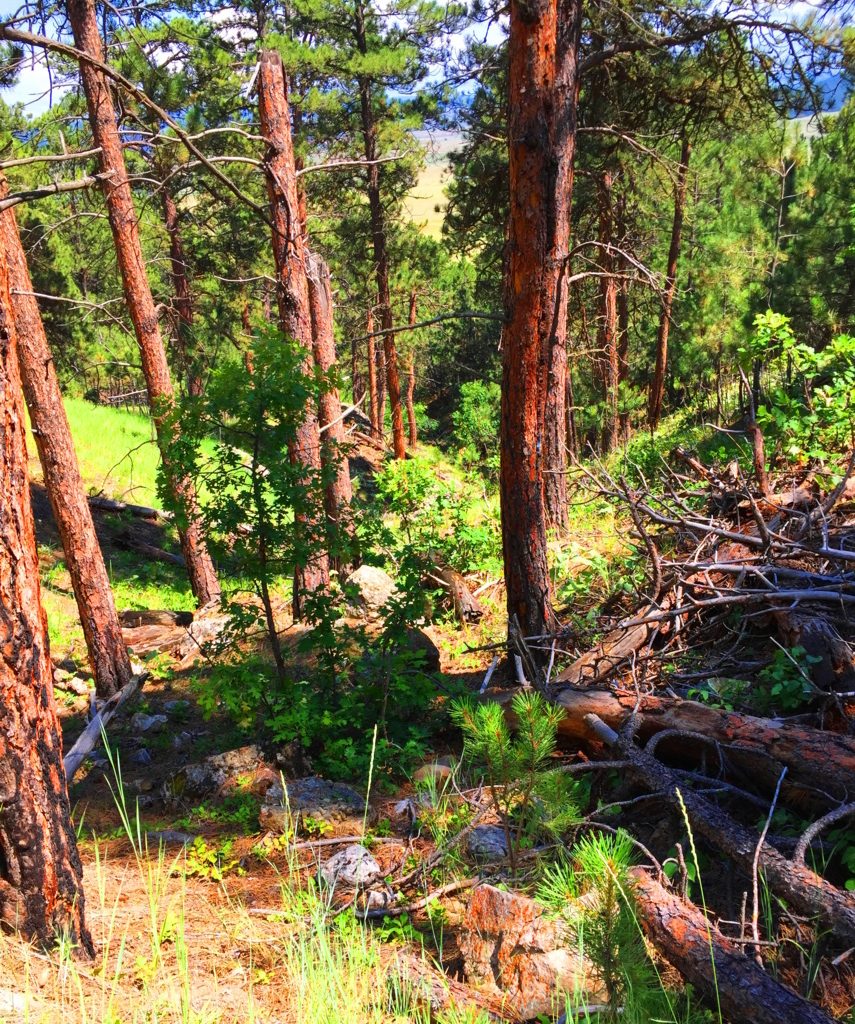 The path appears to be a modern work of Cub Scouts and campers from the last 100 years. There are no signs of the ancient stony paths found in Celtic heights, New England, or northern Colorado. The one factor that is entirely unique to this space is the level of quiet, if that is possible to measure. It is simply a denser quiet. Even the regular sounds of hawks or wild goats are not heard in these hills. It will make you more aware of yourself in return. Often times it’s a moment to say to yourself: “Well, at least I’m not in my office/in traffic/on-line/ etc etc etc. The Trail switches back a few times as you ascend a solid soil pathway through the Ponderosa treeline (Image/Left). As the hillside reveals itself, there are stones that begin to pop up, of a type I had never seen before. As the trail levels off near the top of the initial knoll, it begins to veer into the deeper woods, and boulders akin to what is found on the ledges of New England, begin appear. I have to admit that the ledges and boulders here were so ancient looking, so old, that I realized I had never seen this specific type before. Ancient Wyoming boulders are practically rust colored with orange and brown spots. (Image/Below/Right) This is very similar to the pattern on Alpine stones found in the heights of Mount Katahdin (Below/Left). Look at the Same rare spotted pattern, although they are very different colors.
The path appears to be a modern work of Cub Scouts and campers from the last 100 years. There are no signs of the ancient stony paths found in Celtic heights, New England, or northern Colorado. The one factor that is entirely unique to this space is the level of quiet, if that is possible to measure. It is simply a denser quiet. Even the regular sounds of hawks or wild goats are not heard in these hills. It will make you more aware of yourself in return. Often times it’s a moment to say to yourself: “Well, at least I’m not in my office/in traffic/on-line/ etc etc etc. The Trail switches back a few times as you ascend a solid soil pathway through the Ponderosa treeline (Image/Left). As the hillside reveals itself, there are stones that begin to pop up, of a type I had never seen before. As the trail levels off near the top of the initial knoll, it begins to veer into the deeper woods, and boulders akin to what is found on the ledges of New England, begin appear. I have to admit that the ledges and boulders here were so ancient looking, so old, that I realized I had never seen this specific type before. Ancient Wyoming boulders are practically rust colored with orange and brown spots. (Image/Below/Right) This is very similar to the pattern on Alpine stones found in the heights of Mount Katahdin (Below/Left). Look at the Same rare spotted pattern, although they are very different colors. 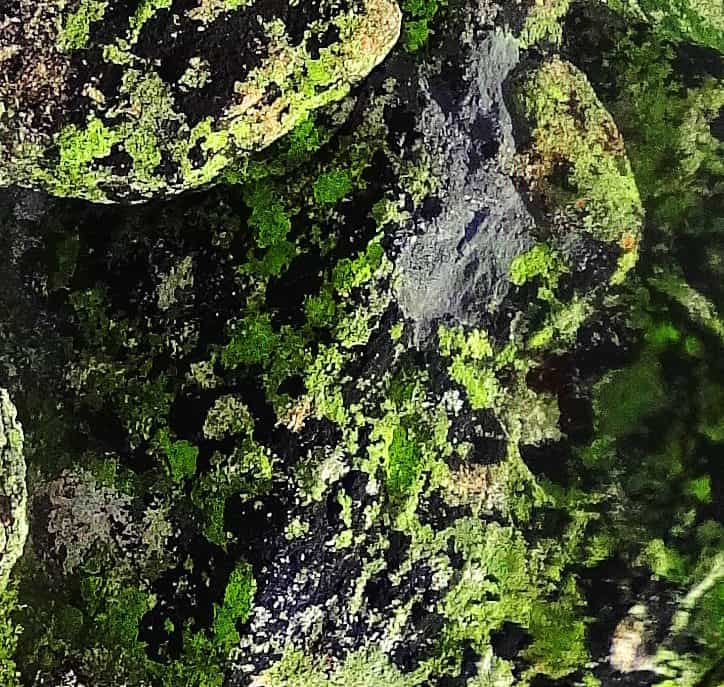
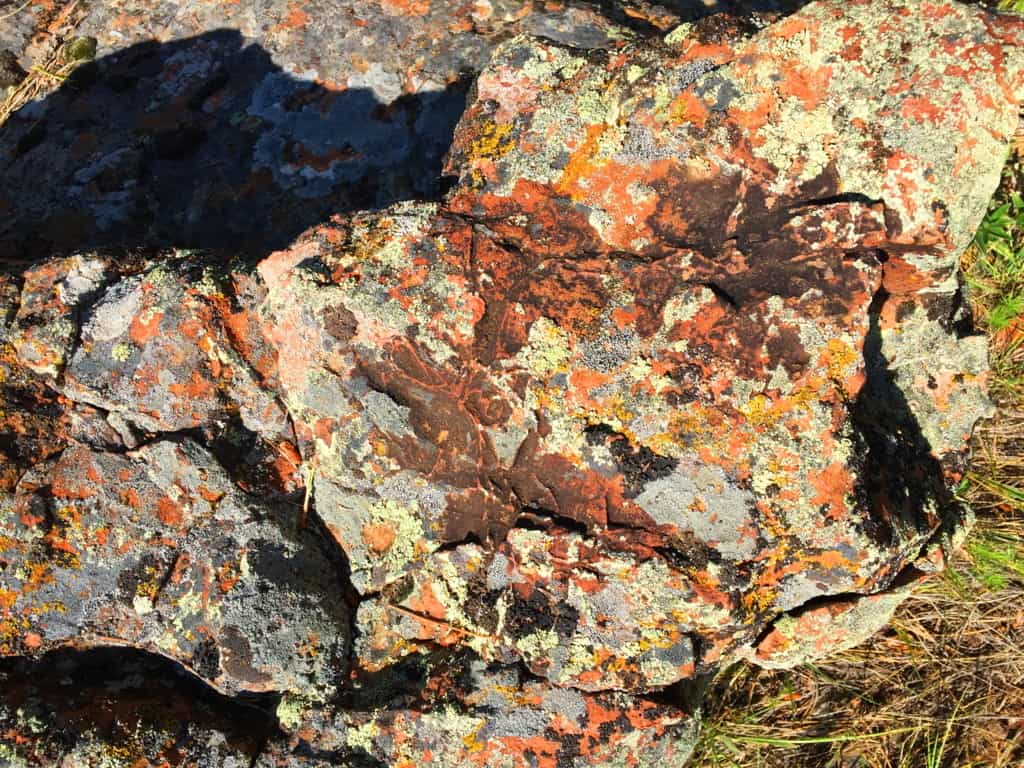 There are also boulders in auspicious vantage points throughout the early portion of the upper trail.(Image/Below) You can see cut-sections of ancient hillside stone, with a free standing boulder on the upper left corner in the image, in an advantageous vantage-point above, just like on New England ledges. Whoever put these boulders there are the first occupants of this land, before the Native Americans arrived.
There are also boulders in auspicious vantage points throughout the early portion of the upper trail.(Image/Below) You can see cut-sections of ancient hillside stone, with a free standing boulder on the upper left corner in the image, in an advantageous vantage-point above, just like on New England ledges. Whoever put these boulders there are the first occupants of this land, before the Native Americans arrived.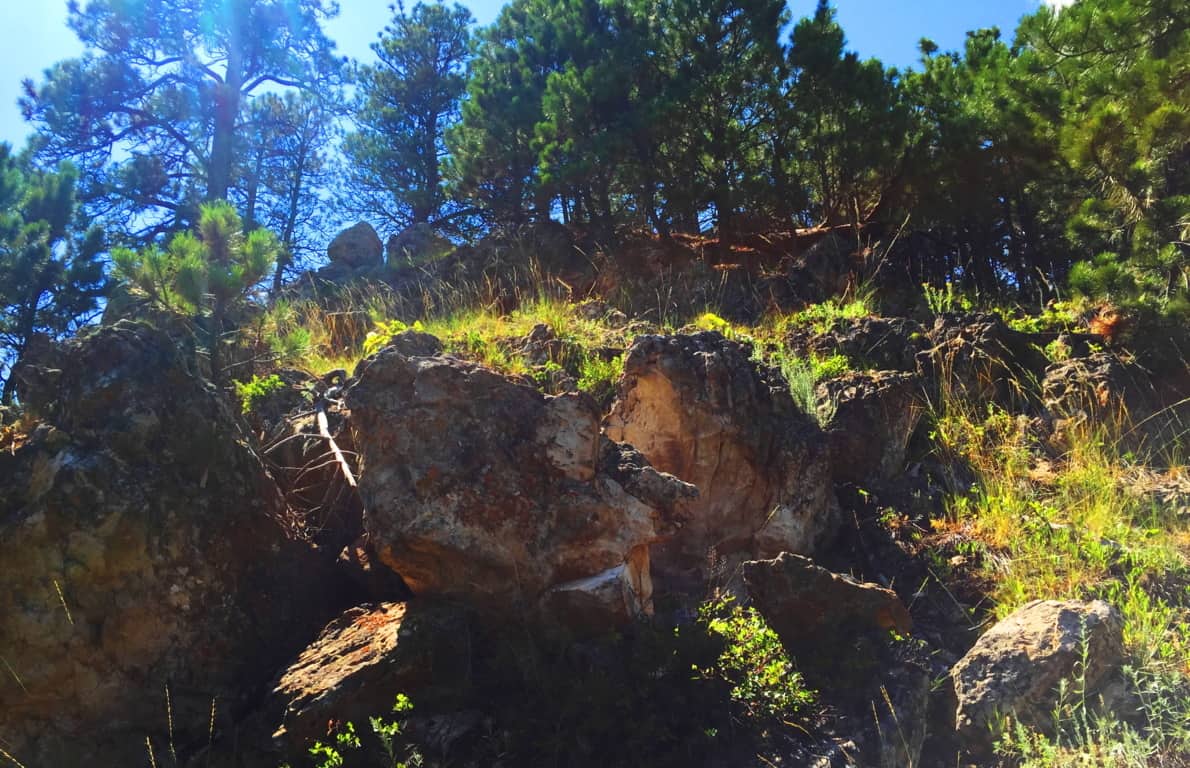 The places where the stones are cut, and stacked, on top of each other are most often the most beautiful views facing outward, not hidden in the forest. Again, this is so similar to Ireland and New England that it is nearly impossible to ignore. Look how distinctly the stone is cut and set in a fixture in the image below.
The places where the stones are cut, and stacked, on top of each other are most often the most beautiful views facing outward, not hidden in the forest. Again, this is so similar to Ireland and New England that it is nearly impossible to ignore. Look how distinctly the stone is cut and set in a fixture in the image below.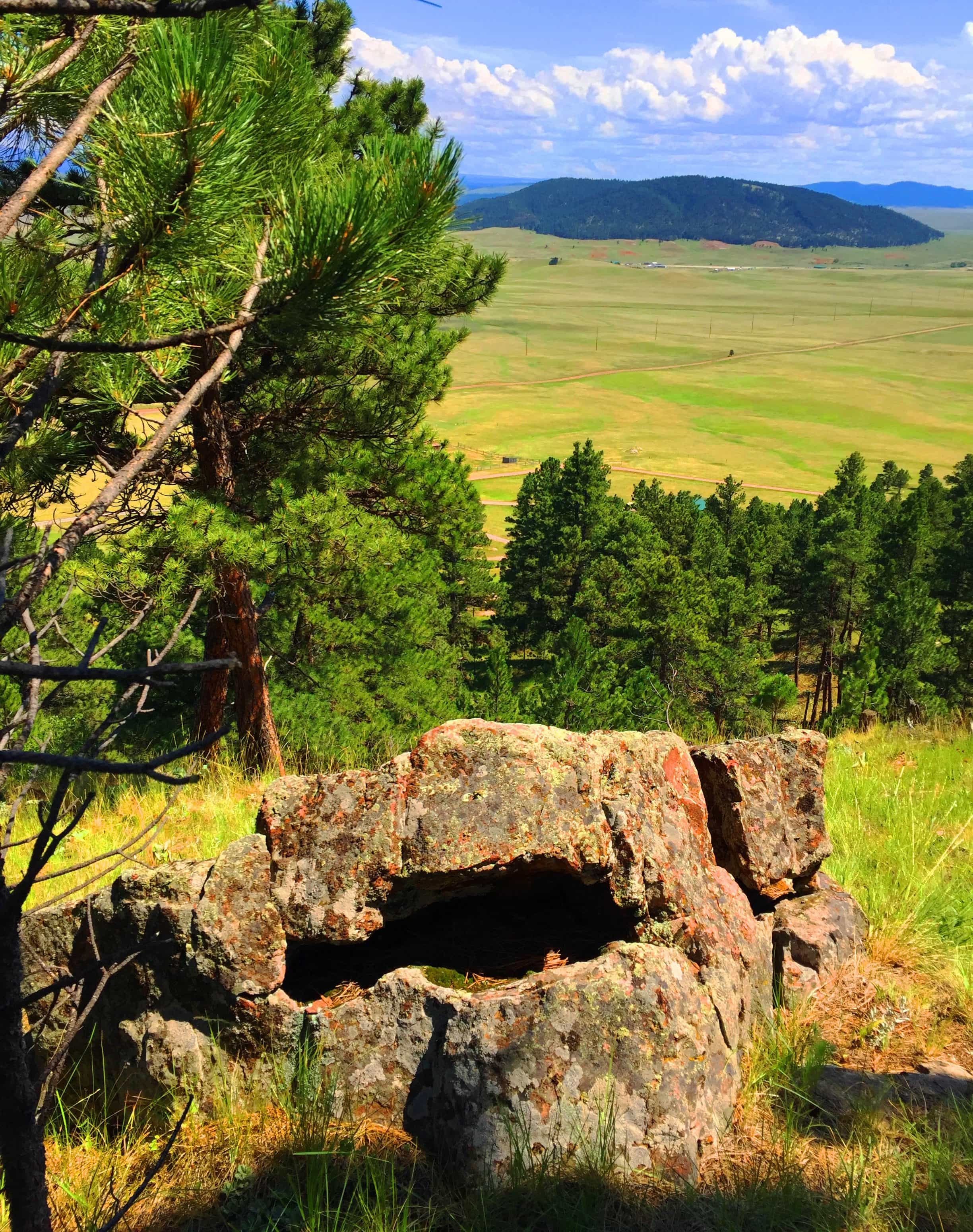 The second third of the trail, the upper trail, becomes gorgeous forest. This is a beautiful stretch of trees and thickets, and there is a temptation to wander into it, leaving the path behind. I don’t recommend going off-trail on a first excursion, but with time, and more knowledge of the range, it might be possible some day in the future.
The second third of the trail, the upper trail, becomes gorgeous forest. This is a beautiful stretch of trees and thickets, and there is a temptation to wander into it, leaving the path behind. I don’t recommend going off-trail on a first excursion, but with time, and more knowledge of the range, it might be possible some day in the future.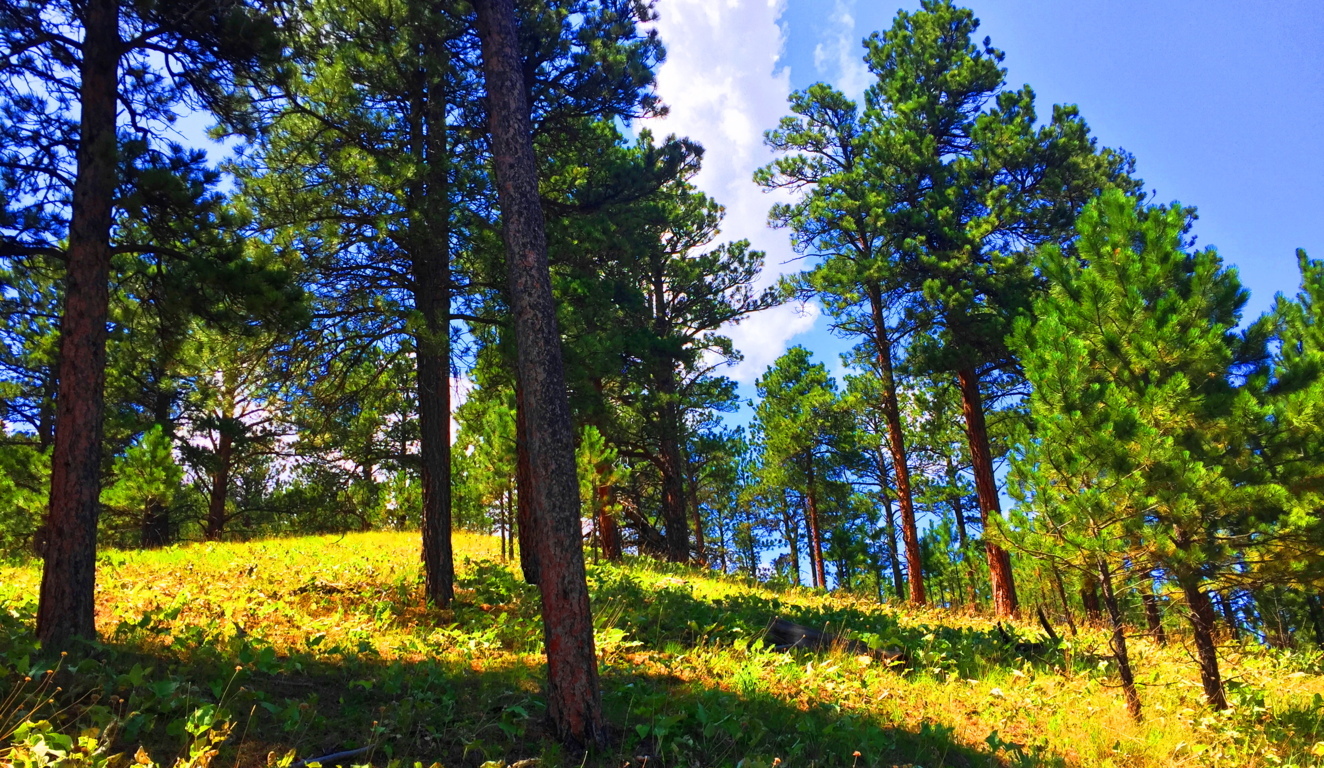
The upper vale in any range, whether it’s the White Mountains of Vermont, or The Berkshires of New York, are almost always a type of secondary dimension. You step through them, only to have them change as you go. Your perspective can change from ‘surrounded by pillars of reddish brown’ to ‘sifting through small shafts of milky-white limbs’; i.e: Ponderosa’s to Birch’s. This might be hard for a hiking layman to understand, but a particular grove can change the way you feel. The Ponderosa Pine grove (Image/Above) is a distinctly different feeling than the Birch grove (Image/Below). Harder still it is to comprehend for many beginners, is that forests, in this manner, teach us about our level of receptivity and perception. Imagine what happen if you chance to walk through 50 forests, or 100, in this lifetime. 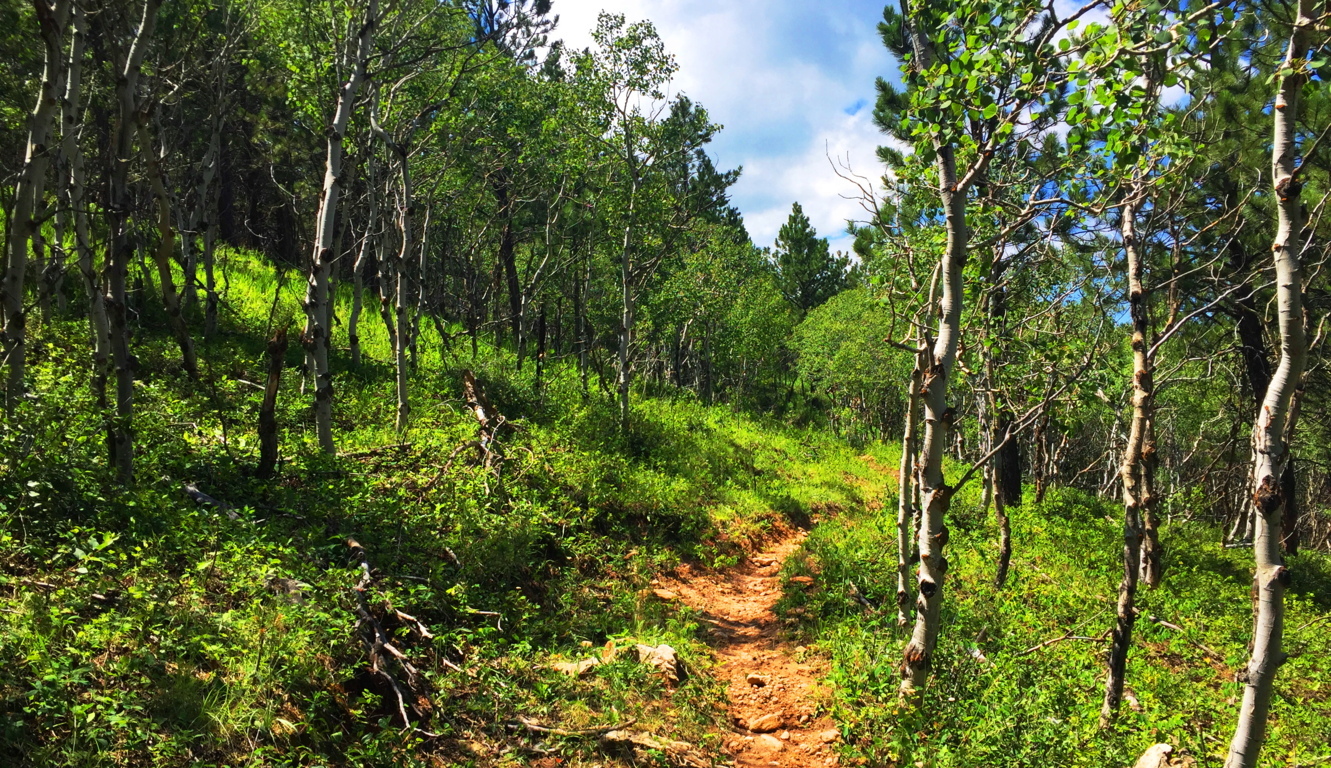 On the higher end of that receptivity is realizing and experiencing sacred zones. They feel beyond Time. Places where megaliths are found are almost always in accordance with this mystical feeling, and we are discovering through dynamic new anthropology that this is anything but wishful thinking. There are entire forests and ranges in New England and Ireland that have connective engineering throughout the entire landscape (See Cavan Burren National Park/Stonestrider.com). The landscape is literally stone-grafted to synergize the experience of moving through it. Most people, even in this age, just can’t get their minds around the idea that the entire landscape is a temple or monument, harnessing very real subtle energies. This particular trail in Wyoming is a chance to see the contrast between landscapes that are inundated with stone-linings, and those that are not, and what that might mean. Why is there not a single stone-lining in these beautiful small-mountains, while in New England there are enough Stone-linings to circle the Earth several times over? What does it mean?
On the higher end of that receptivity is realizing and experiencing sacred zones. They feel beyond Time. Places where megaliths are found are almost always in accordance with this mystical feeling, and we are discovering through dynamic new anthropology that this is anything but wishful thinking. There are entire forests and ranges in New England and Ireland that have connective engineering throughout the entire landscape (See Cavan Burren National Park/Stonestrider.com). The landscape is literally stone-grafted to synergize the experience of moving through it. Most people, even in this age, just can’t get their minds around the idea that the entire landscape is a temple or monument, harnessing very real subtle energies. This particular trail in Wyoming is a chance to see the contrast between landscapes that are inundated with stone-linings, and those that are not, and what that might mean. Why is there not a single stone-lining in these beautiful small-mountains, while in New England there are enough Stone-linings to circle the Earth several times over? What does it mean?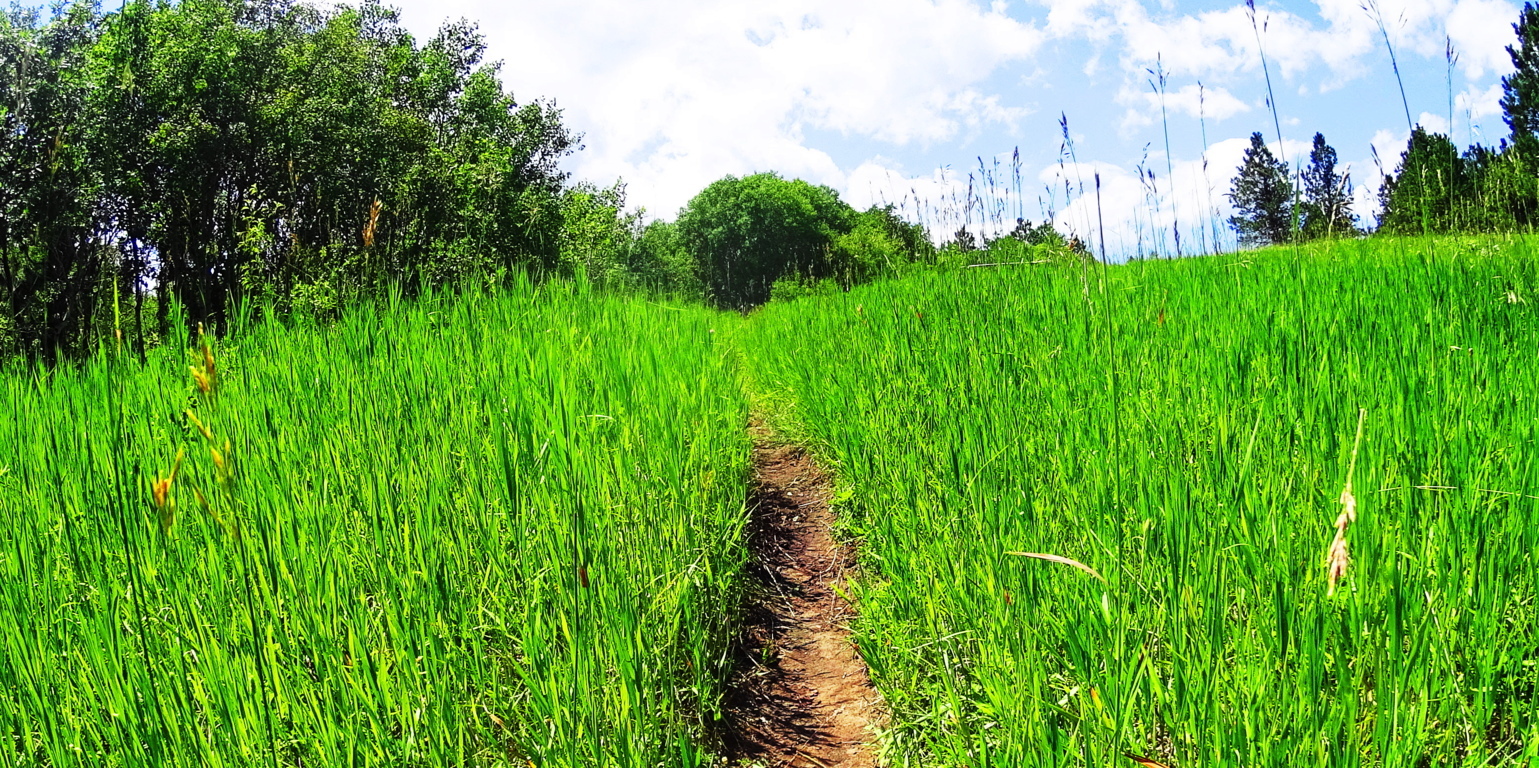 The trail here at Black Hills opens up into elevated fields of thriving grass beds within the glades, with absolutely no stone distinctions. You can almost picture an Arapaho Native materializing out of the woods, with nothing particular on his mind in this absolute tranquility. Prairie Asters emerge along the path, as well as what looks like a lavender Lonicera type flower. Entire fields of these wildflowers appeared across the next range, several miles from this spot, and everything about these beds indicates a vibrant, happy, and healthy zone.
The trail here at Black Hills opens up into elevated fields of thriving grass beds within the glades, with absolutely no stone distinctions. You can almost picture an Arapaho Native materializing out of the woods, with nothing particular on his mind in this absolute tranquility. Prairie Asters emerge along the path, as well as what looks like a lavender Lonicera type flower. Entire fields of these wildflowers appeared across the next range, several miles from this spot, and everything about these beds indicates a vibrant, happy, and healthy zone.

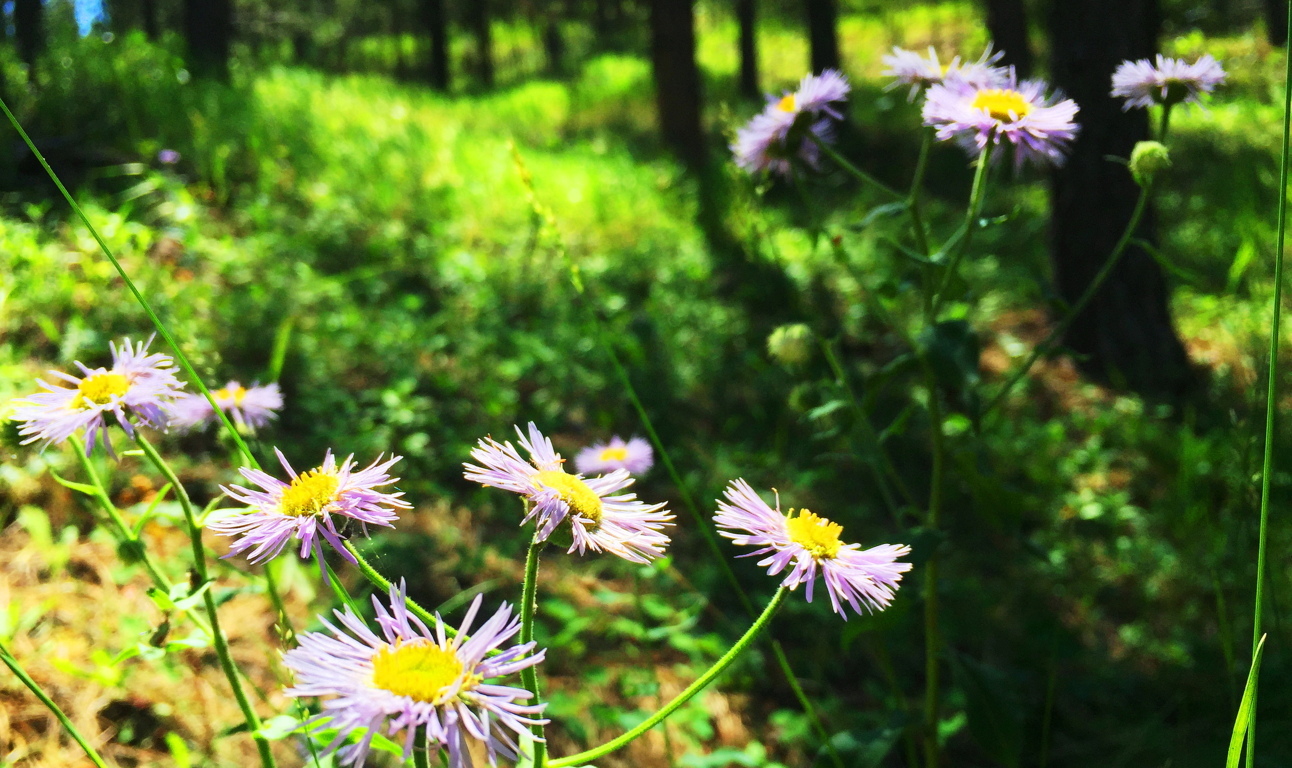
The cover photo of this article, at the very top of the page, looks to be the objective of this Black Hills Trail. It’s a fine view across the valley. This is a place to sit down for a while. Impressively, the trail doesn’t loop back, it continues rolling on through several small Ranges to the north, perhaps as much as another ten miles after this 2.5 mile section.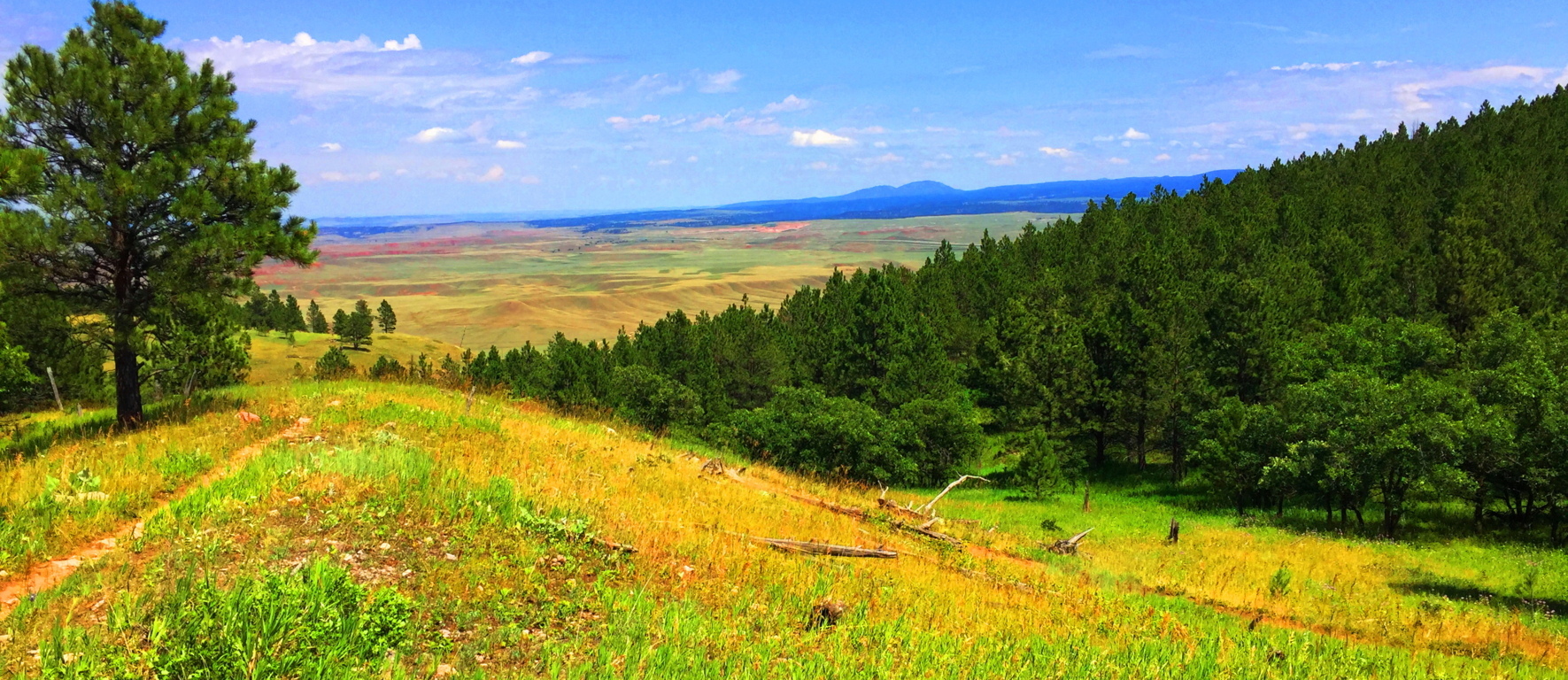
To exit the Trail, simply head back the way you came, and enjoy each ridge and the views they offer as you go.
There are places that are more intrinsically natural than others. Everything about Wyoming says “Don’t worry.” The Black Hills is a Trail that forces you to wonder how many of your problems are self induced. The peace in a place like this is so stunning that there is a cleansing of any spirit that passes through it, like a “landlocked baptism.” Landscapes don’t always have to reveal specific megalithic statements to be sacred. The land itself is at the heart of the ability to feel the sacred. It is entirely possible to see and feel the calm that the Native Americans felt for thousands upon thousands of years, and there are still ancient echoes of what was here before, written in the stone ridges. In a contentious time like this, Black Hills Trail is pure medicine, a regenerating tranquility that can take any modern confusion that you might have, and massage it into a cosmic calm so abundantly represented in the hills of Wyoming. Those who ignorantly accuse places like this of being “boring” are already drowning in a technological pool of hyper-urbanized poison. Wyoming is gorgeous, peaceful, mysterious, and gracious, with each and every step, and each step you take through it, is a step closer to your better-self. Black Hills Wyoming is part of the answer in this world, not a source of division; what more do you need to hear? Explore our world, and leave those that are trying to control and monitor every move you make, far, far, behind. Thanks for reading Stonestrider.com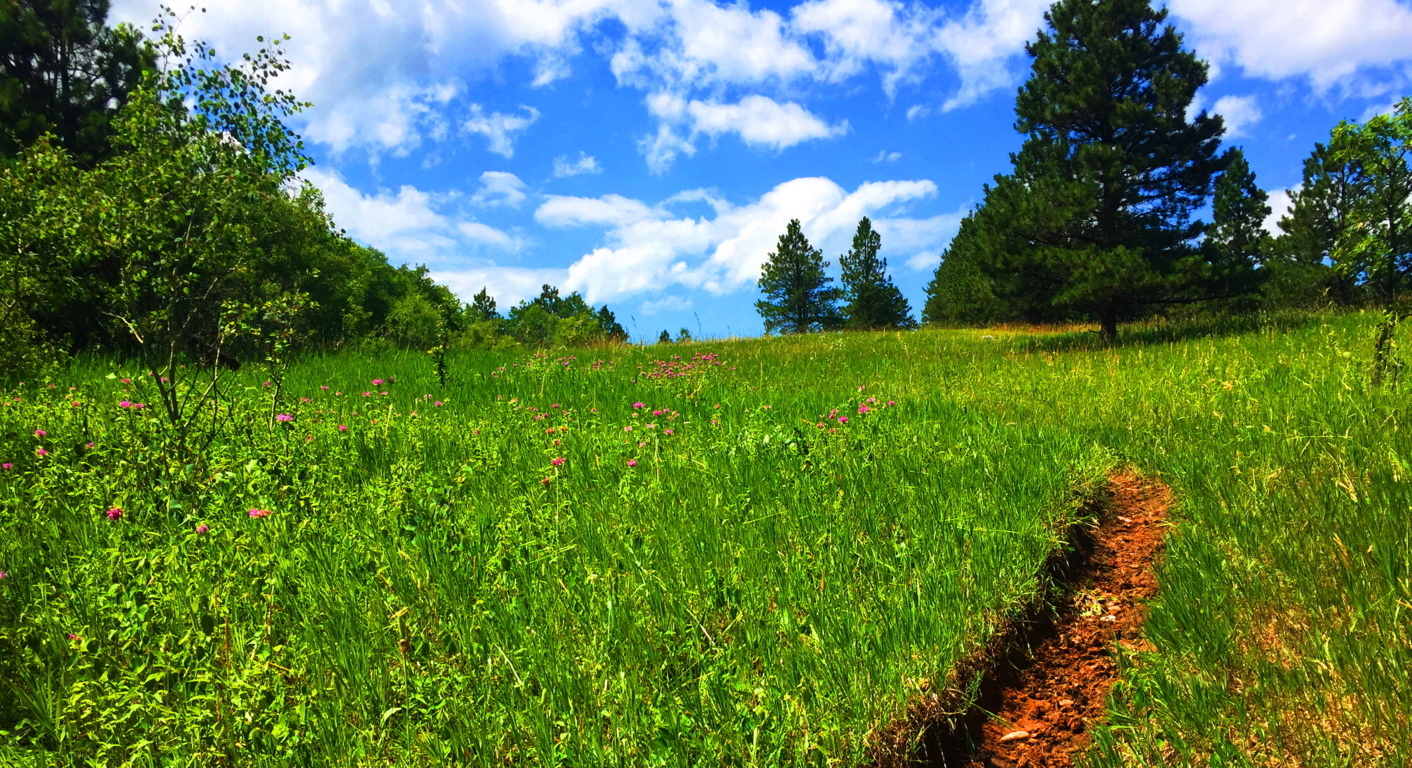
Medicine Bow National Park
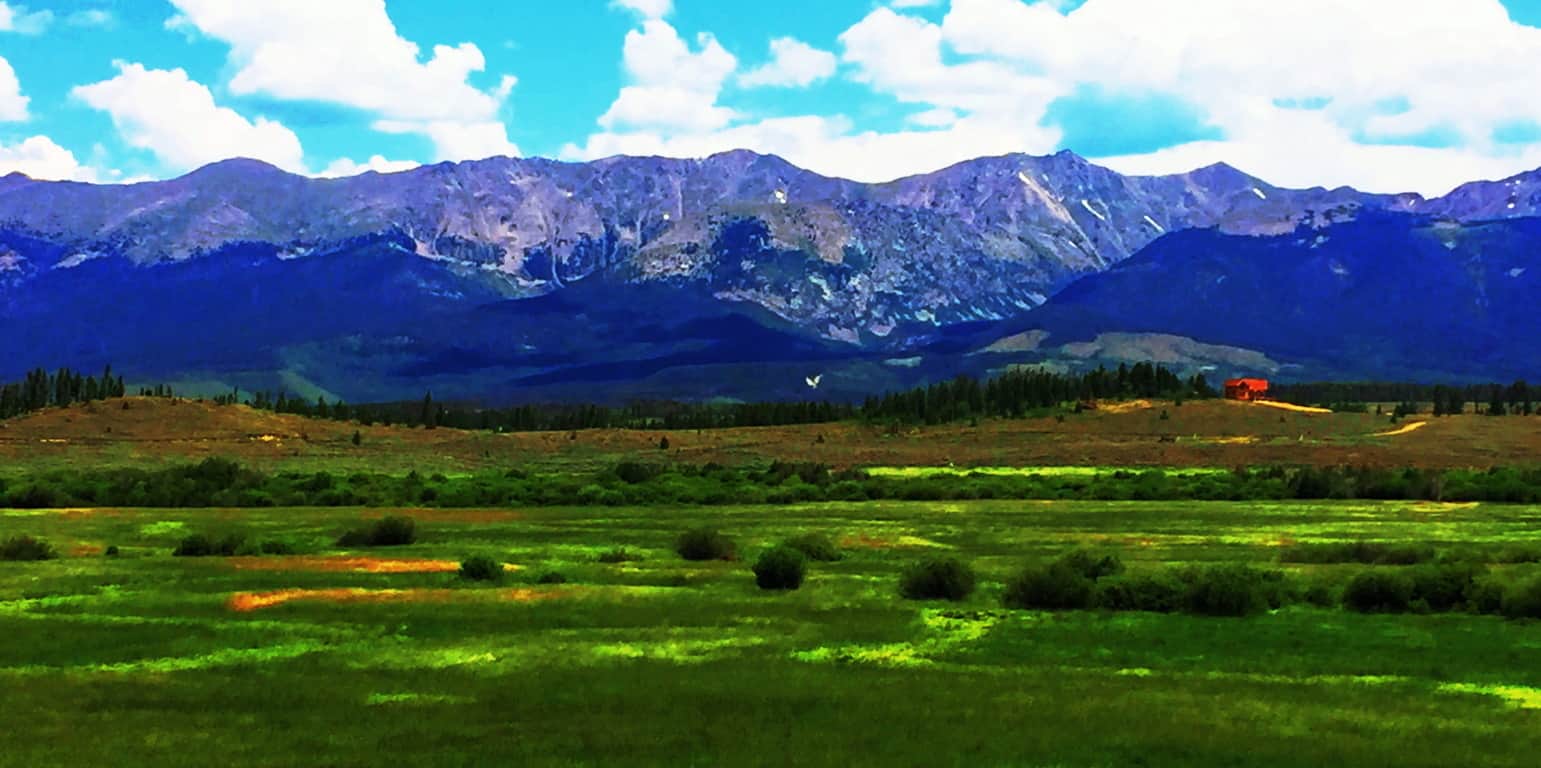
Location: Clark Peak/Rocky Mountains/Colorado
Elevation: 12,953
Prominence: 2,753
Note: If the mountain ranges of Ireland, Wales, and England could be said to be like rolling waves of infinite green…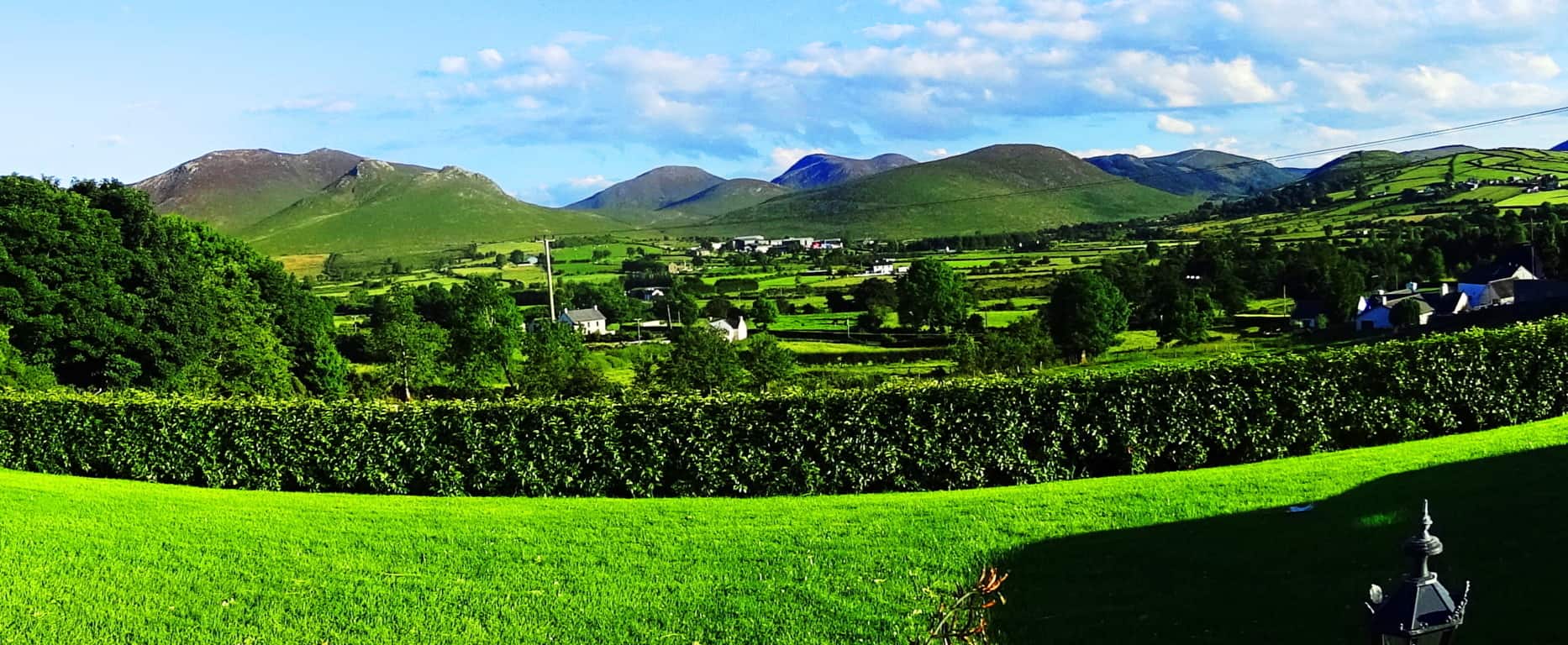 …then the Colorado Rockies of the northwest United States could be said to be nothing less than a rock-solid “tsunami of blue stone”, frozen forever along the landscape, above the western world.
…then the Colorado Rockies of the northwest United States could be said to be nothing less than a rock-solid “tsunami of blue stone”, frozen forever along the landscape, above the western world.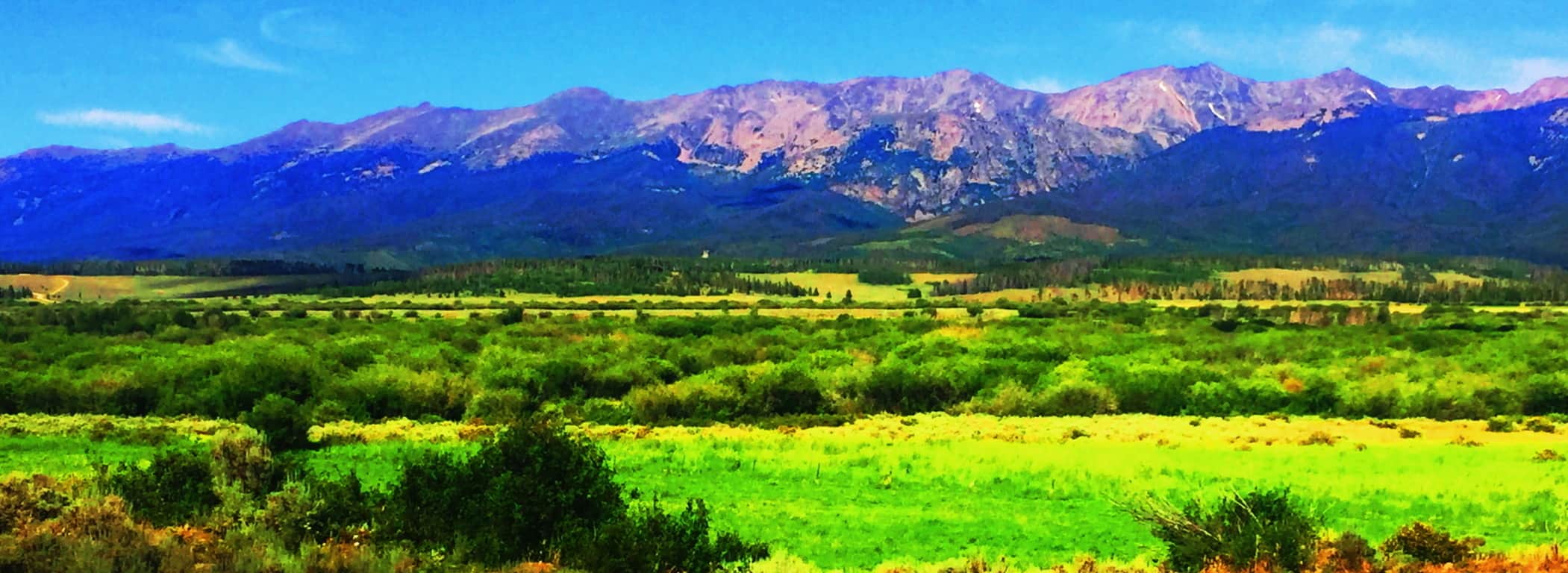 There is no other possible introduction to this juggernaut of a mountain range. Clark Peak, our destination for this article, sits in the southern Medicine Bow National Park. The northern Medicine Bow National Park, across the state line in Wyoming, is an auspicious type of “warm-up” for the grandeur of The Rockies. Southern Wyoming’s Medicine Bow’ features a unique lessor-known range, with ‘chocolate-milk’ looking soil, seemingly poured all over the ledges, standing at what looks to be about 2000 inviting feet of prominence with the highway running right through them. (Image/Below)
There is no other possible introduction to this juggernaut of a mountain range. Clark Peak, our destination for this article, sits in the southern Medicine Bow National Park. The northern Medicine Bow National Park, across the state line in Wyoming, is an auspicious type of “warm-up” for the grandeur of The Rockies. Southern Wyoming’s Medicine Bow’ features a unique lessor-known range, with ‘chocolate-milk’ looking soil, seemingly poured all over the ledges, standing at what looks to be about 2000 inviting feet of prominence with the highway running right through them. (Image/Below)
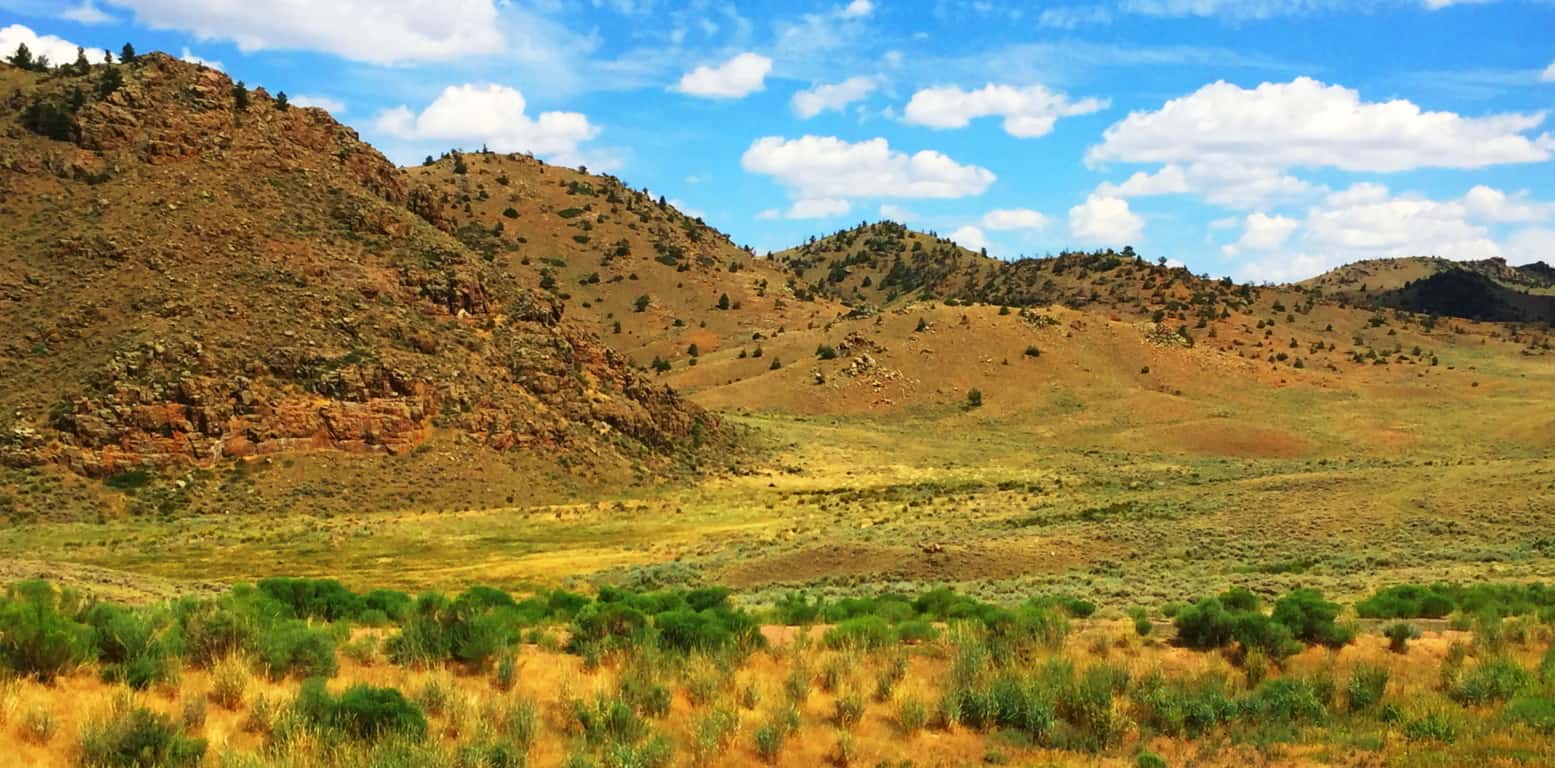 These are surprisingly dramatic yet relatively anonymous mountains, a mere preview to what looms just across the State line. They are absolutely worthy of many an expedition for certain, but remain in the reputational shadow of what awaits in Colorado. To its credit, a mere glimpse of these small peaks reveals a warm and distinct beauty, truly inviting. Everything about this small range says “jump up here for a day!” Like so many people just passing through, this place was passed by in order to reach the Rocky Mountains of Colorado.
These are surprisingly dramatic yet relatively anonymous mountains, a mere preview to what looms just across the State line. They are absolutely worthy of many an expedition for certain, but remain in the reputational shadow of what awaits in Colorado. To its credit, a mere glimpse of these small peaks reveals a warm and distinct beauty, truly inviting. Everything about this small range says “jump up here for a day!” Like so many people just passing through, this place was passed by in order to reach the Rocky Mountains of Colorado.
Clark Peak Trail: The feel of Colorado is vast and rustic, and yet it leaves natural space for significant delicate statements also. Trails are thickly bedded with wildflowers of every possible color, like the approach to the mythical city of Oz. Brown Bears and Moose roam the mountains and forests, but for the most part steer clear of the trails. The high plain sits about 9000 feet above sea-level, supporting a universe of fauna. 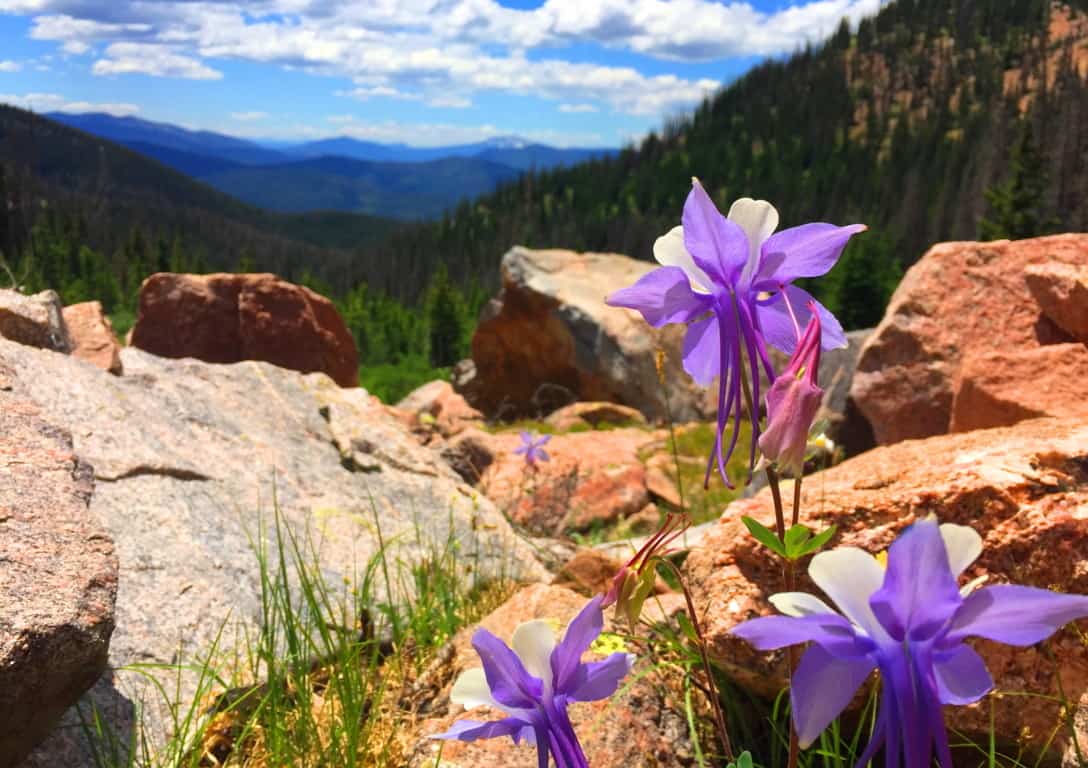 Accessing the elevated trails of Medicine Bow National Park in high country like this requires a 4×4 vehicle, plain and simple. The highest peak of Medicine Bow’, above the northern Rockies, is Clark Peak, looming just shy of 13,000 feet above sea-level. There are basically three levels of trail-heads, each a bit further up the Trail than the next. The first trail-head approaching Clark Peak is at the end of a wide dirt track that passes a small lake on the far edge of the mountains. To start from the first trail-head could basically take more than a day to complete the ascent and return. Most hikers attempting the peak desire an entry that reaches to at least the second trail-head. You should not attempt the second or third trail-head without a 4×4 truck, and prepare to rent a 4×4 for your excursion. Below is an image of the Clark Peak approach. Above the high basin on the left is your destination, where a large still-water pool awaits.
Accessing the elevated trails of Medicine Bow National Park in high country like this requires a 4×4 vehicle, plain and simple. The highest peak of Medicine Bow’, above the northern Rockies, is Clark Peak, looming just shy of 13,000 feet above sea-level. There are basically three levels of trail-heads, each a bit further up the Trail than the next. The first trail-head approaching Clark Peak is at the end of a wide dirt track that passes a small lake on the far edge of the mountains. To start from the first trail-head could basically take more than a day to complete the ascent and return. Most hikers attempting the peak desire an entry that reaches to at least the second trail-head. You should not attempt the second or third trail-head without a 4×4 truck, and prepare to rent a 4×4 for your excursion. Below is an image of the Clark Peak approach. Above the high basin on the left is your destination, where a large still-water pool awaits.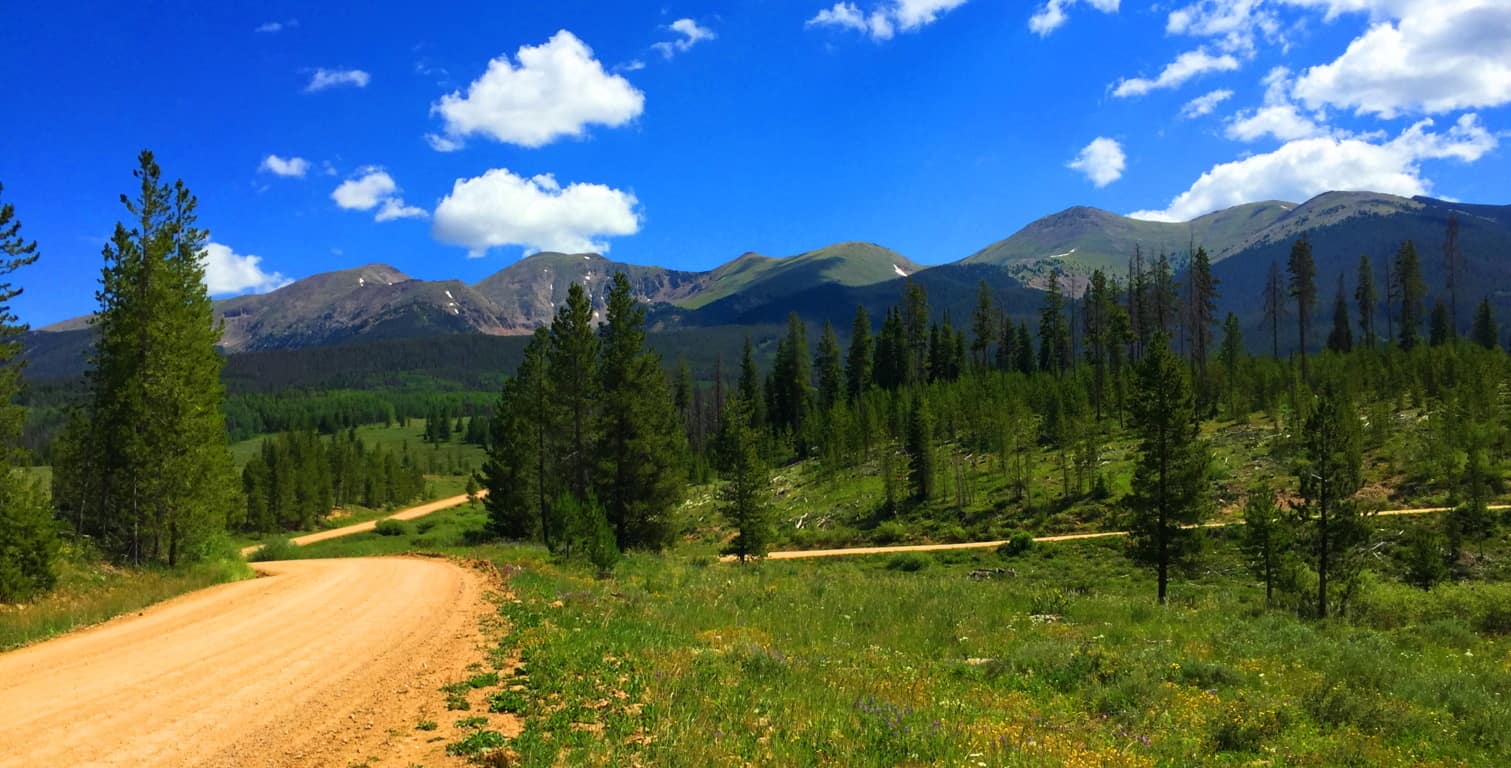 The second trail-head begins about 5 miles into the lower vale, so when you ditch the truck on the side of the track, the forest will already be surrounding you, and perhaps in a way it has never done before (even for seasoned cross trainers.) If this is your first hike in Colorado, you are stepping into a type of hiking phantasy from the moment you get out of the truck.
The second trail-head begins about 5 miles into the lower vale, so when you ditch the truck on the side of the track, the forest will already be surrounding you, and perhaps in a way it has never done before (even for seasoned cross trainers.) If this is your first hike in Colorado, you are stepping into a type of hiking phantasy from the moment you get out of the truck.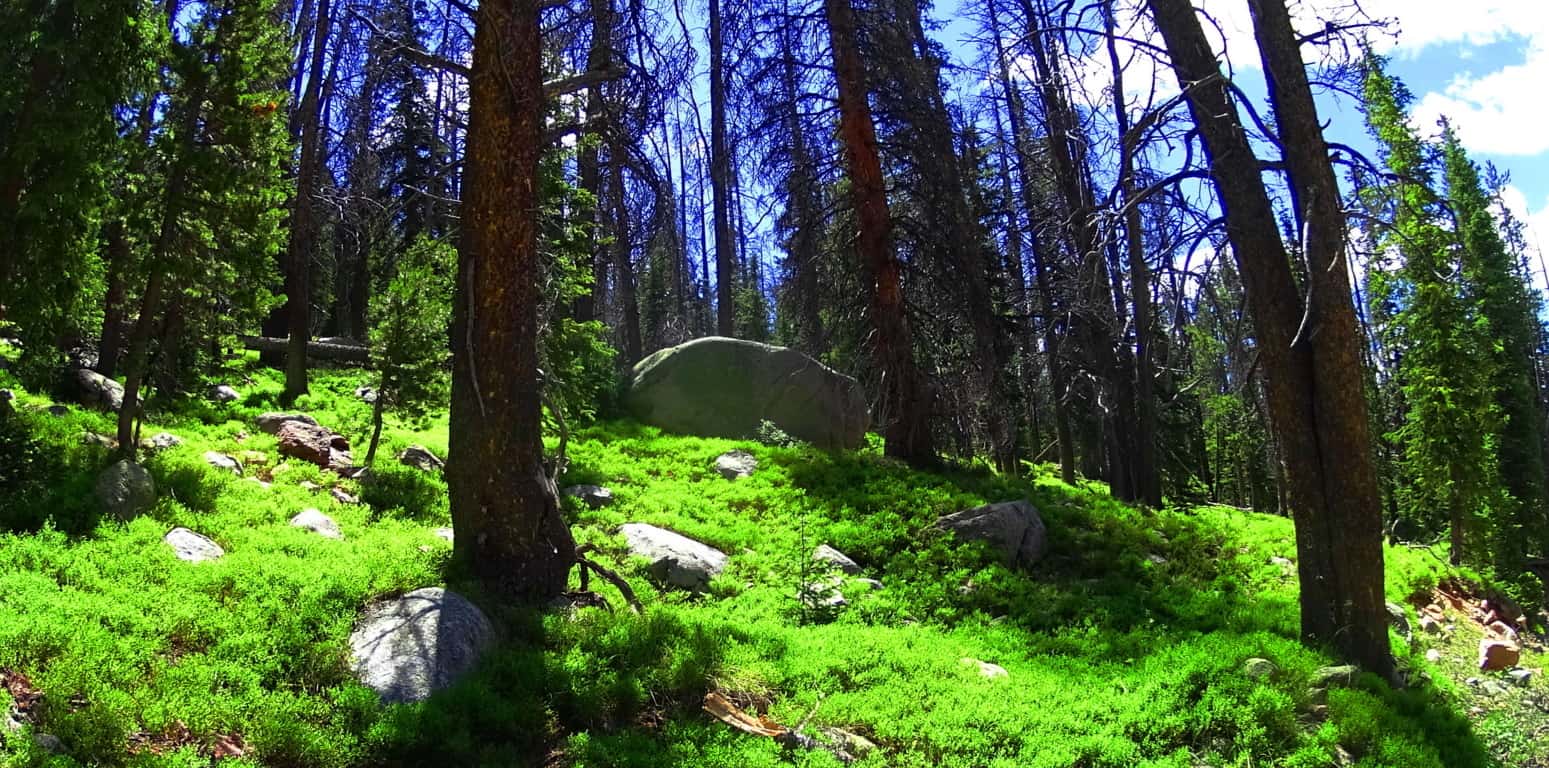 The tallness and fineness of the Aspen trees, Blue Spruces, Douglas Firs, Ponderosa Pines, and Lodgepole Pines, creates a literal euphoric vibe in the forest. From a distance, the woodlands seem to be blending into each other somehow. When the shafts of sunlight hit these trees, it is hard to focus on any single thing; it’s as if the trees are literally vibrating into each other.
The tallness and fineness of the Aspen trees, Blue Spruces, Douglas Firs, Ponderosa Pines, and Lodgepole Pines, creates a literal euphoric vibe in the forest. From a distance, the woodlands seem to be blending into each other somehow. When the shafts of sunlight hit these trees, it is hard to focus on any single thing; it’s as if the trees are literally vibrating into each other. 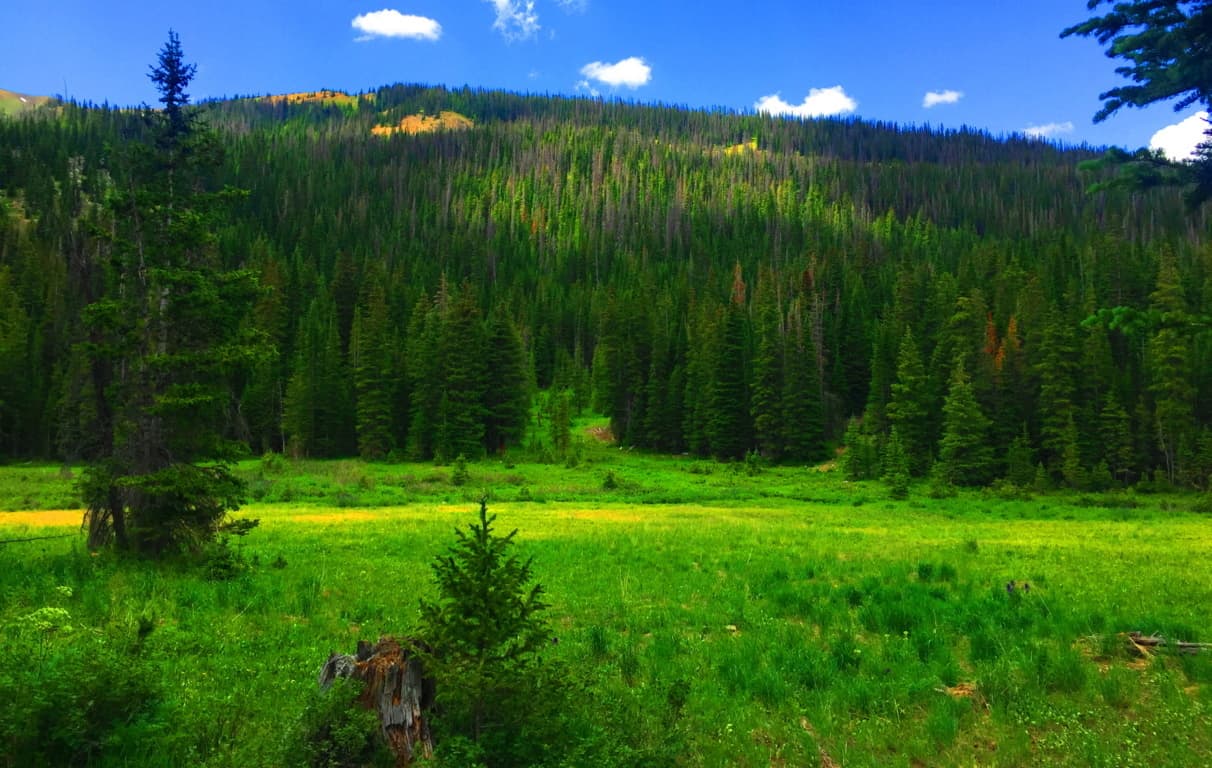 There is a type of enchantment here, a vastness to these glades that gives a very physical impression. The thickets here look as dense and deep as any ocean, and just like the ocean, to go too deep un-prepared could prove fatal. Respect this wilderness, pack properly, study-up, and stay on the trail when inside the forest. The basics here are about being aware of ‘forest-fire warning-levels’ and the restrictions to using flame, the possibility of bringing bear-spray (or even a fire-arm), and never leaving cooked food/food goods unburied or littered in the forest; it will draw the Brown Bears if you are lazy and careless with your goods. Stay sharp and aware, ready to have a great experience.
There is a type of enchantment here, a vastness to these glades that gives a very physical impression. The thickets here look as dense and deep as any ocean, and just like the ocean, to go too deep un-prepared could prove fatal. Respect this wilderness, pack properly, study-up, and stay on the trail when inside the forest. The basics here are about being aware of ‘forest-fire warning-levels’ and the restrictions to using flame, the possibility of bringing bear-spray (or even a fire-arm), and never leaving cooked food/food goods unburied or littered in the forest; it will draw the Brown Bears if you are lazy and careless with your goods. Stay sharp and aware, ready to have a great experience.
Very much like in the Mourn Mountains in Ireland, after the lower valley roads begin to elevate, they usually blend into a stone road trail that is almost certainly an ancient pathway. I wondered if I would find such a thing in a wilderness so far removed from Celtic characteristics, and to my delight I did. The look of these rocky tracks are surprising in the initial heights of any mountain range. In many places it seems that these ancient pathways were the very first roads on Earth, navigating the high mountain passes built by the most ancient Culture on Earth, the Neolithic Culture. Here is a look at the ancient stone-road at Mount Bearnagh in Ireland. (Image/Below) 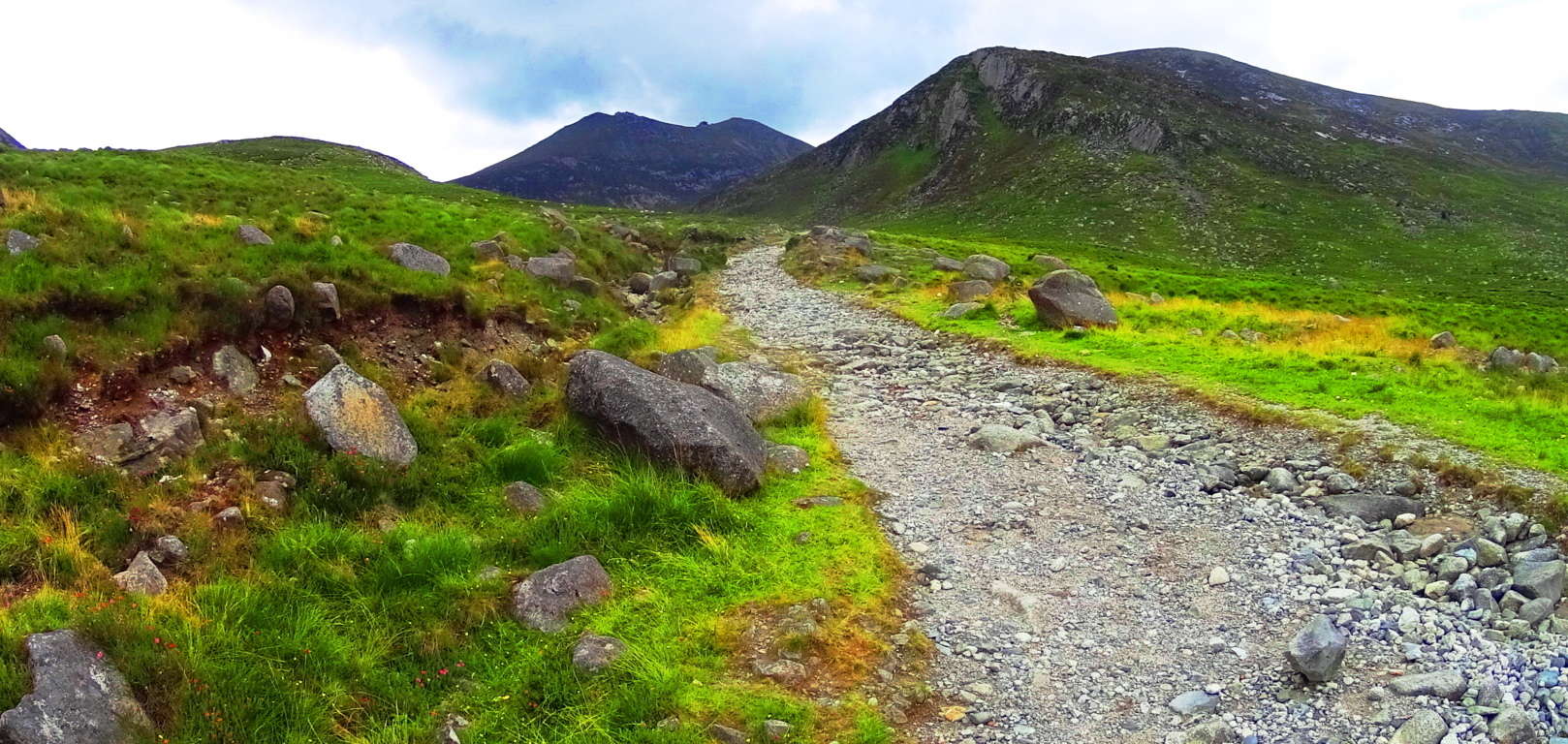 And now here is a look at the nearly identical width grade, and angle of an ancient stone-path in Colorado.(Image/Below) Many of these approaches have been re-worked from a much older original path that has been there (for all intents and purposes) forever. In Ireland it would be the Gaelic/Celtic Culture that identified and revised the ancient paths, while in Colorado, the Native Americans would have been the first to observed and acknowledge these trails as “sacred pathways”, or “pathways of the spirits.” These origin roads had existed long before even their earliest ancestors had arrived. The point is, there is very good reason to believe that an even more ancient culture existed here before the natives, a culture capable of building and engineering with megalithic stones. To my great wonder, some of these signs of “cut stones” and a singular pathways with a specific measurement (roughly 4.5 feet across) in the high mountains appeared here on Clark Peak Trail. A deciphering look at the old pathways alone, however, is not enough evidence to support the idea of a Neolithic existence in this place; it will be in the heights that Wedge Tombs, Cairns, Standing Stones, and Vantage Stones reveal themselves, as we know from Celtic ranges. I admit that this was on my mind as I ascended the beautiful valley with one of my oldest and best friends.
And now here is a look at the nearly identical width grade, and angle of an ancient stone-path in Colorado.(Image/Below) Many of these approaches have been re-worked from a much older original path that has been there (for all intents and purposes) forever. In Ireland it would be the Gaelic/Celtic Culture that identified and revised the ancient paths, while in Colorado, the Native Americans would have been the first to observed and acknowledge these trails as “sacred pathways”, or “pathways of the spirits.” These origin roads had existed long before even their earliest ancestors had arrived. The point is, there is very good reason to believe that an even more ancient culture existed here before the natives, a culture capable of building and engineering with megalithic stones. To my great wonder, some of these signs of “cut stones” and a singular pathways with a specific measurement (roughly 4.5 feet across) in the high mountains appeared here on Clark Peak Trail. A deciphering look at the old pathways alone, however, is not enough evidence to support the idea of a Neolithic existence in this place; it will be in the heights that Wedge Tombs, Cairns, Standing Stones, and Vantage Stones reveal themselves, as we know from Celtic ranges. I admit that this was on my mind as I ascended the beautiful valley with one of my oldest and best friends. 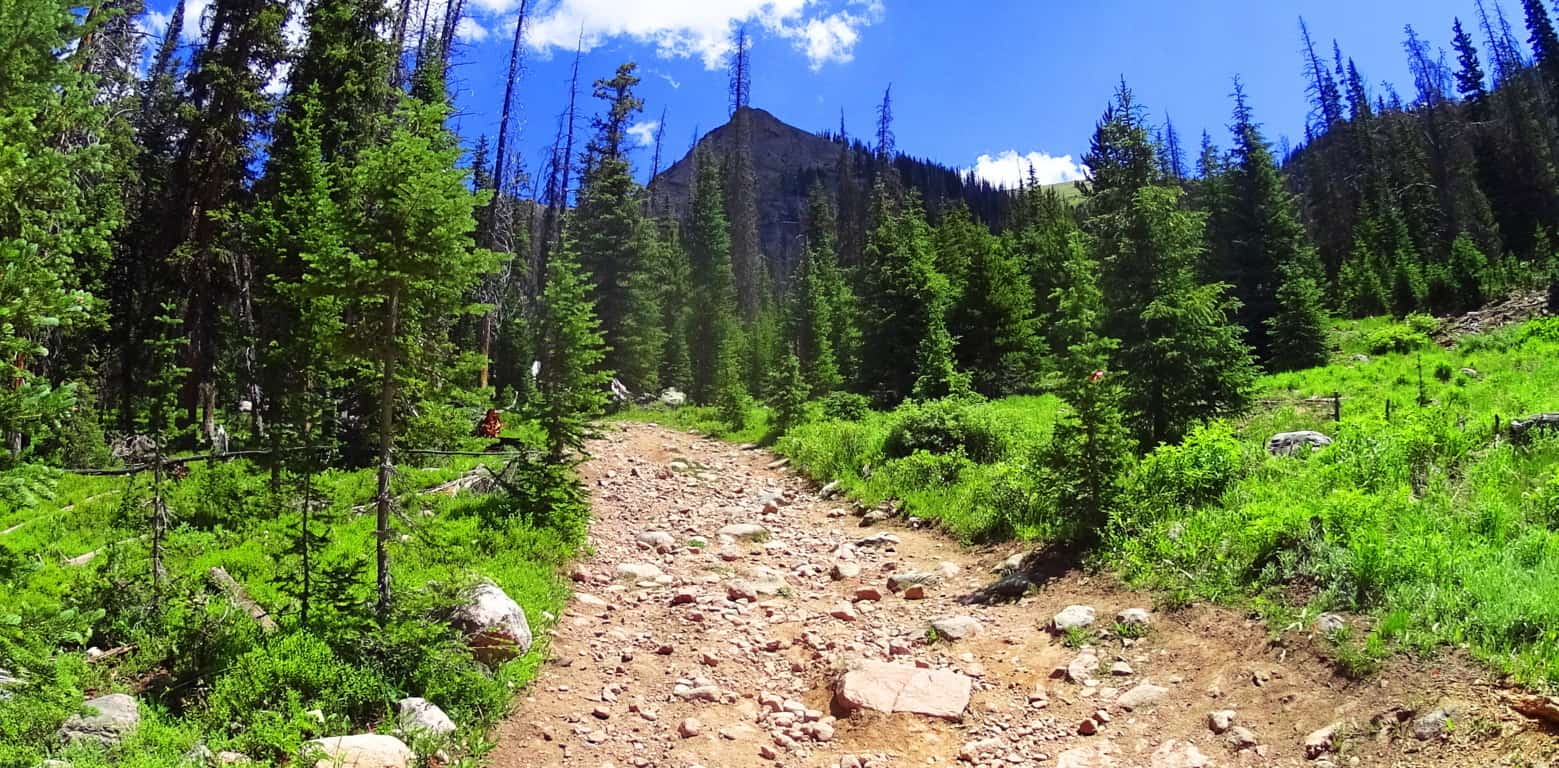
As the old rocky road begins to narrow into a winding path, bustling streams and narrow log bridges emerge. The stream runs almost directly towards Clark Peak, in a line of sight that is classic Colorado; Pines and abundant overgrowth pointing to the peak as if it were a temple corner stone.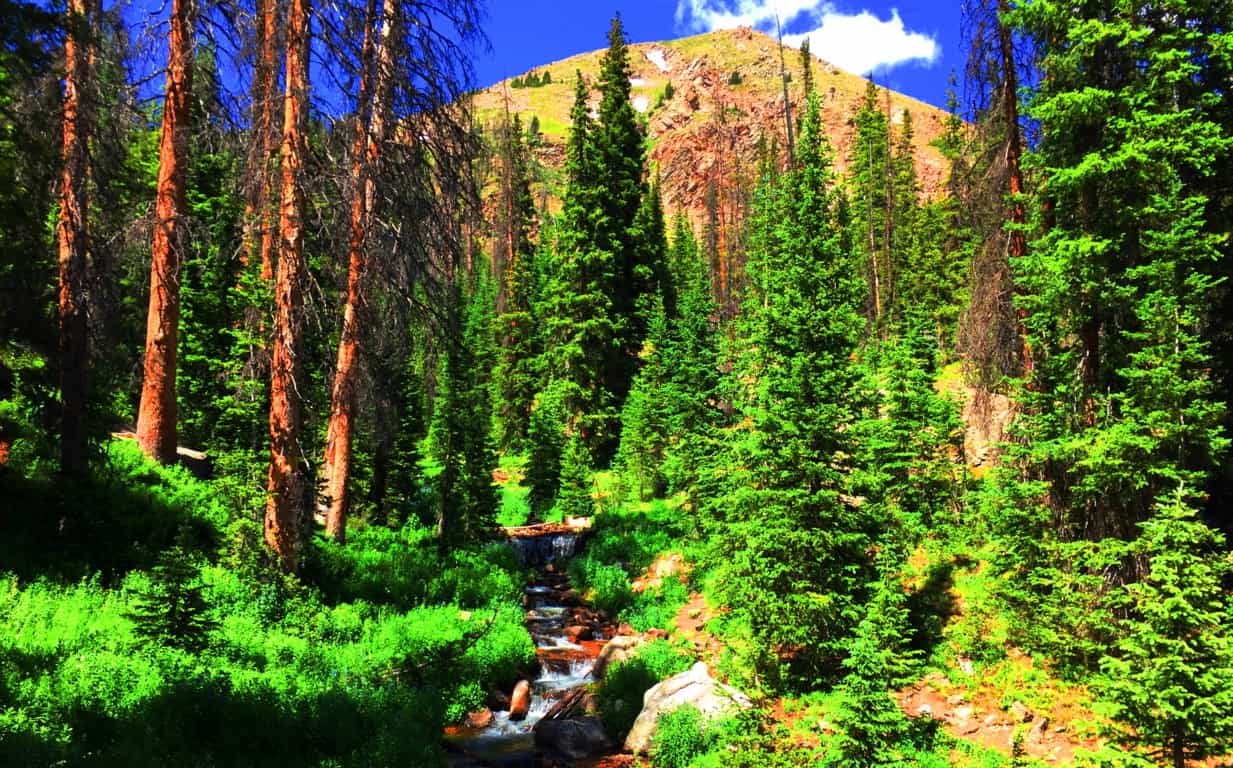 The basin at the upper portion of the trail comes into clear view here, along with a grand clearing in the middle of the vale, about a mile ahead on the trail. A clearing of this scale, where the tree-line abruptly ends, is indicative of a glacial rockslide, which is what we found. The trail continues across the fallen rocks where you catch a first glimpse of the curvature of the glowing moss and speckled glades of the upper basin, which still had somewhat miraculous patches of snow, in July! The absolute dryness of the comfortable cool air preserves the snow in the heights, giving subtle surreal contrast against the hillsides.
The basin at the upper portion of the trail comes into clear view here, along with a grand clearing in the middle of the vale, about a mile ahead on the trail. A clearing of this scale, where the tree-line abruptly ends, is indicative of a glacial rockslide, which is what we found. The trail continues across the fallen rocks where you catch a first glimpse of the curvature of the glowing moss and speckled glades of the upper basin, which still had somewhat miraculous patches of snow, in July! The absolute dryness of the comfortable cool air preserves the snow in the heights, giving subtle surreal contrast against the hillsides. 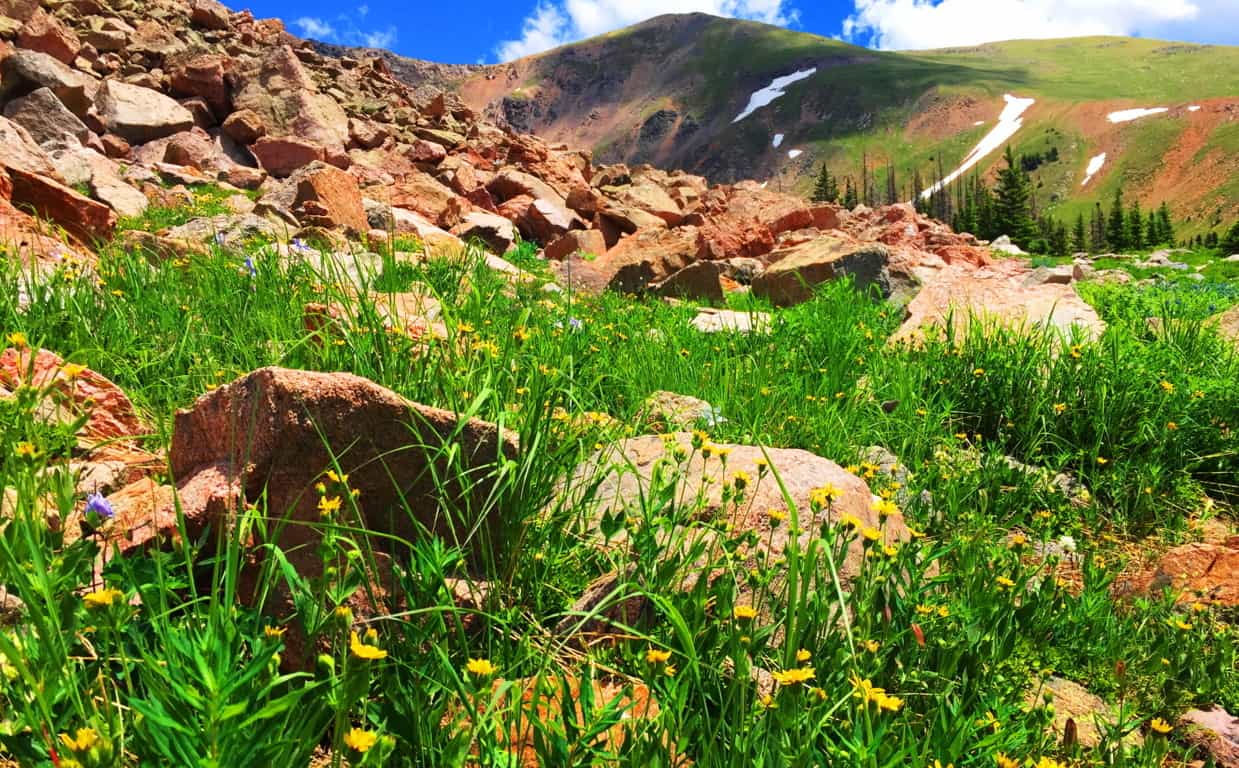 While trekking through a massive rockslide a chronology of the natural events of the mountain comes into perspective. The receding of the last Ice Age left entire mountainsides inundated with random boulders in spastic shambles. Intriguingly, some of the boulders seem to have broken away from the riotously random placement-pattern. One massive ‘squared’ boulder, at the base of the rockslide, seems to be sitting perfectly centered on the incredible scene of the mountains below and beyond. In the upper valley at Mount Bearnagh, of the Mourn Mountain Range of Ireland, not only are there boulders that seem cinematically placed, but they also seem to have been, somehow, hewn to match the shape of the valley beyond. (Image/Below)
While trekking through a massive rockslide a chronology of the natural events of the mountain comes into perspective. The receding of the last Ice Age left entire mountainsides inundated with random boulders in spastic shambles. Intriguingly, some of the boulders seem to have broken away from the riotously random placement-pattern. One massive ‘squared’ boulder, at the base of the rockslide, seems to be sitting perfectly centered on the incredible scene of the mountains below and beyond. In the upper valley at Mount Bearnagh, of the Mourn Mountain Range of Ireland, not only are there boulders that seem cinematically placed, but they also seem to have been, somehow, hewn to match the shape of the valley beyond. (Image/Below)
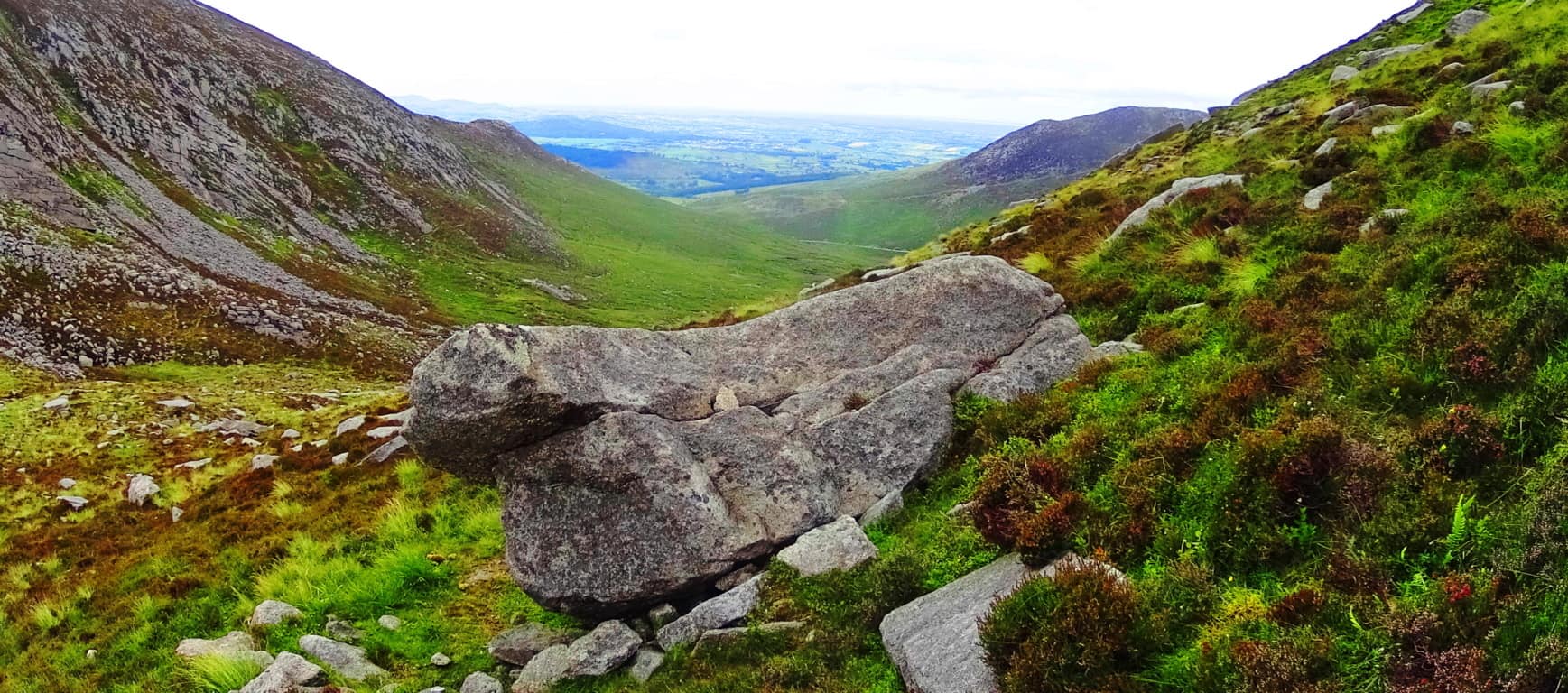
There are also “seat boulders” at the pass at Bearnagh, which absolutely look to have been placed at a cinematic point on the valley, as a place where you could sit and watch anyone approaching slowly from below.(Image/Below)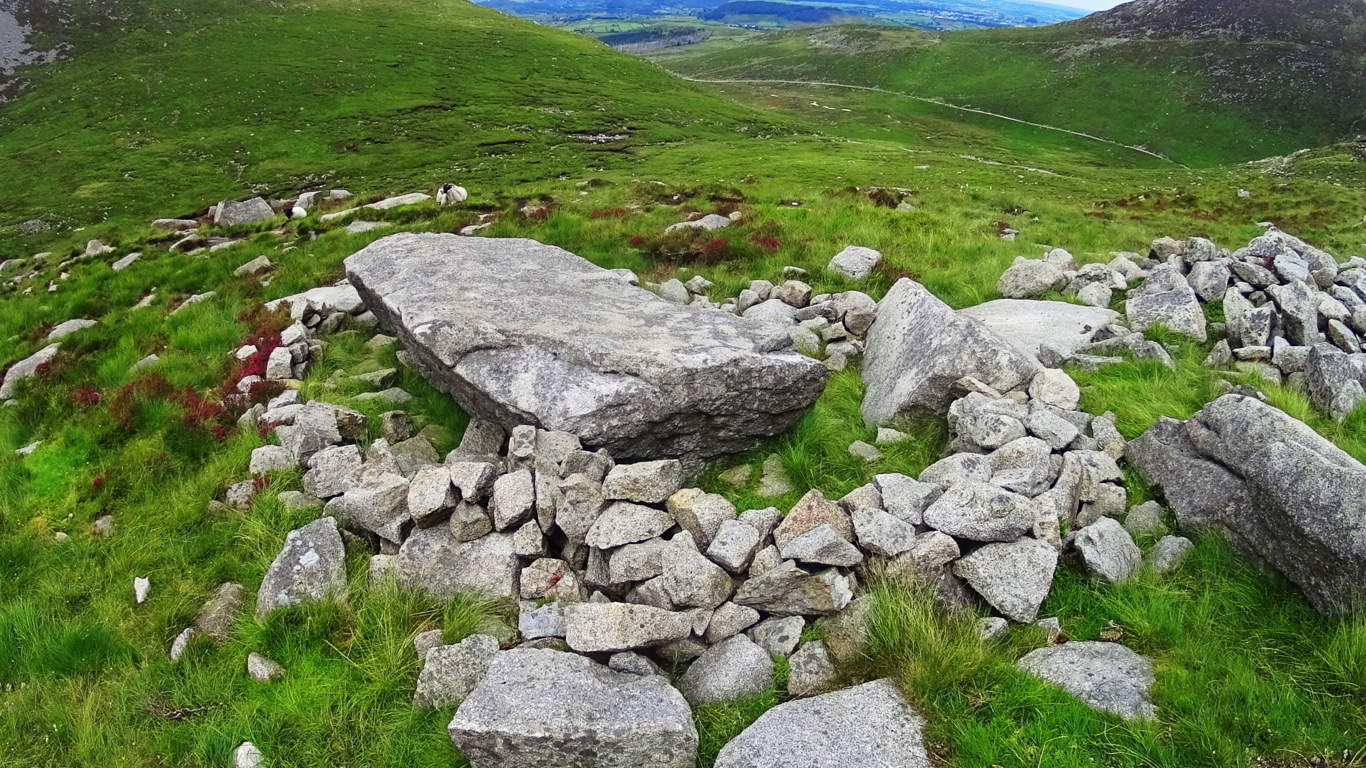 Here at Clark Peak Trail there sits an auspiciously placed boulder which looks more like a “seat” then a random resting place from a rockslide. This ‘squared’ boulder is perfectly centered on the vision that is the brilliant view of The Rockies beyond.(Image/Below) The other stones of this scene are compiled in stacks, tightly packed together, way off to the side of this beautiful seat; and the possibility that it was intentionally placed there becomes very real after considering its perfect symmetrical placement at the dead center of the valley. Only the Neolithic culture, the culture that had the strength and skills to build New Grange, or arrange massive stones in The Mourn Mountains; or masterfully craft the Sarsons at Stonehenge, has the capability to do something of this scale in antiquity. Clark Peak Trail, as you progress, begins to show signs of Neolthic Culture. Clark Peak Trail may very well have been home to the very same Neolithic Culture that marked and roamed the peaks of ancient Europe.
Here at Clark Peak Trail there sits an auspiciously placed boulder which looks more like a “seat” then a random resting place from a rockslide. This ‘squared’ boulder is perfectly centered on the vision that is the brilliant view of The Rockies beyond.(Image/Below) The other stones of this scene are compiled in stacks, tightly packed together, way off to the side of this beautiful seat; and the possibility that it was intentionally placed there becomes very real after considering its perfect symmetrical placement at the dead center of the valley. Only the Neolithic culture, the culture that had the strength and skills to build New Grange, or arrange massive stones in The Mourn Mountains; or masterfully craft the Sarsons at Stonehenge, has the capability to do something of this scale in antiquity. Clark Peak Trail, as you progress, begins to show signs of Neolthic Culture. Clark Peak Trail may very well have been home to the very same Neolithic Culture that marked and roamed the peaks of ancient Europe. 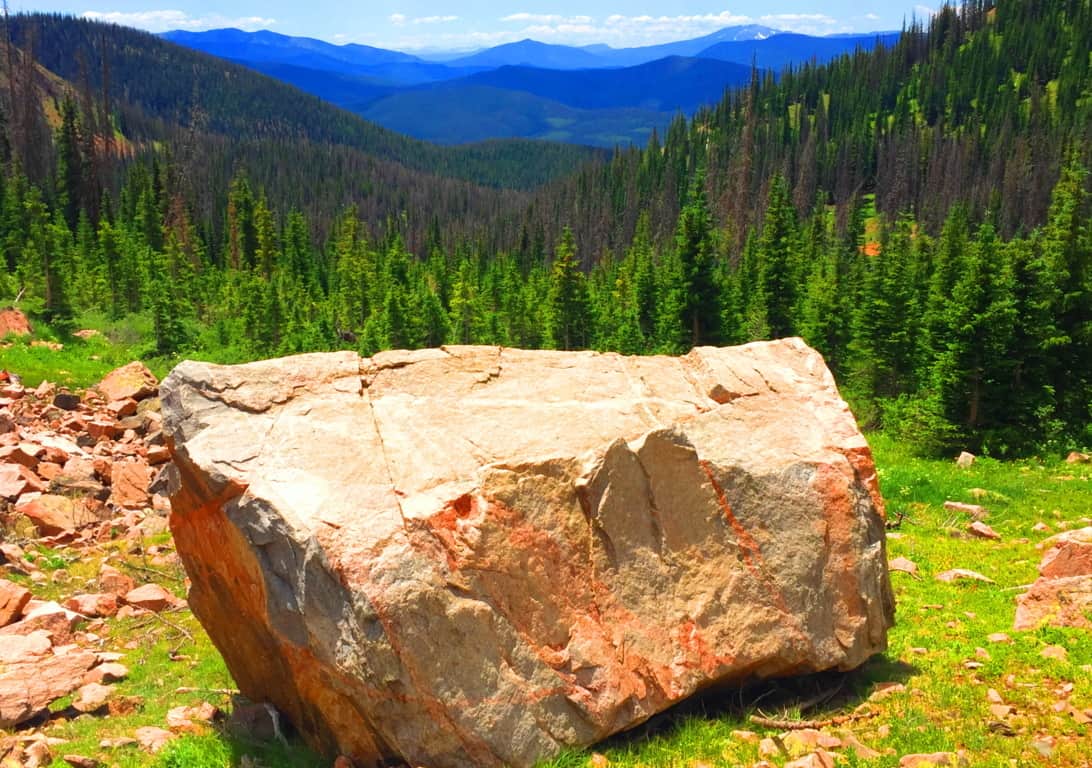 From this gorgeous spot the Trail runs over the landslide stones and into the curvature of the upper basin, where the scene becomes truly surreal. Beautiful fields of wildflowers decorate the mouth of the basin. Campers pitch their tents here on soft glowing beds of grass and singular Pines. The view is like trekking the natural porch taking you straight to Valhalla.
From this gorgeous spot the Trail runs over the landslide stones and into the curvature of the upper basin, where the scene becomes truly surreal. Beautiful fields of wildflowers decorate the mouth of the basin. Campers pitch their tents here on soft glowing beds of grass and singular Pines. The view is like trekking the natural porch taking you straight to Valhalla. 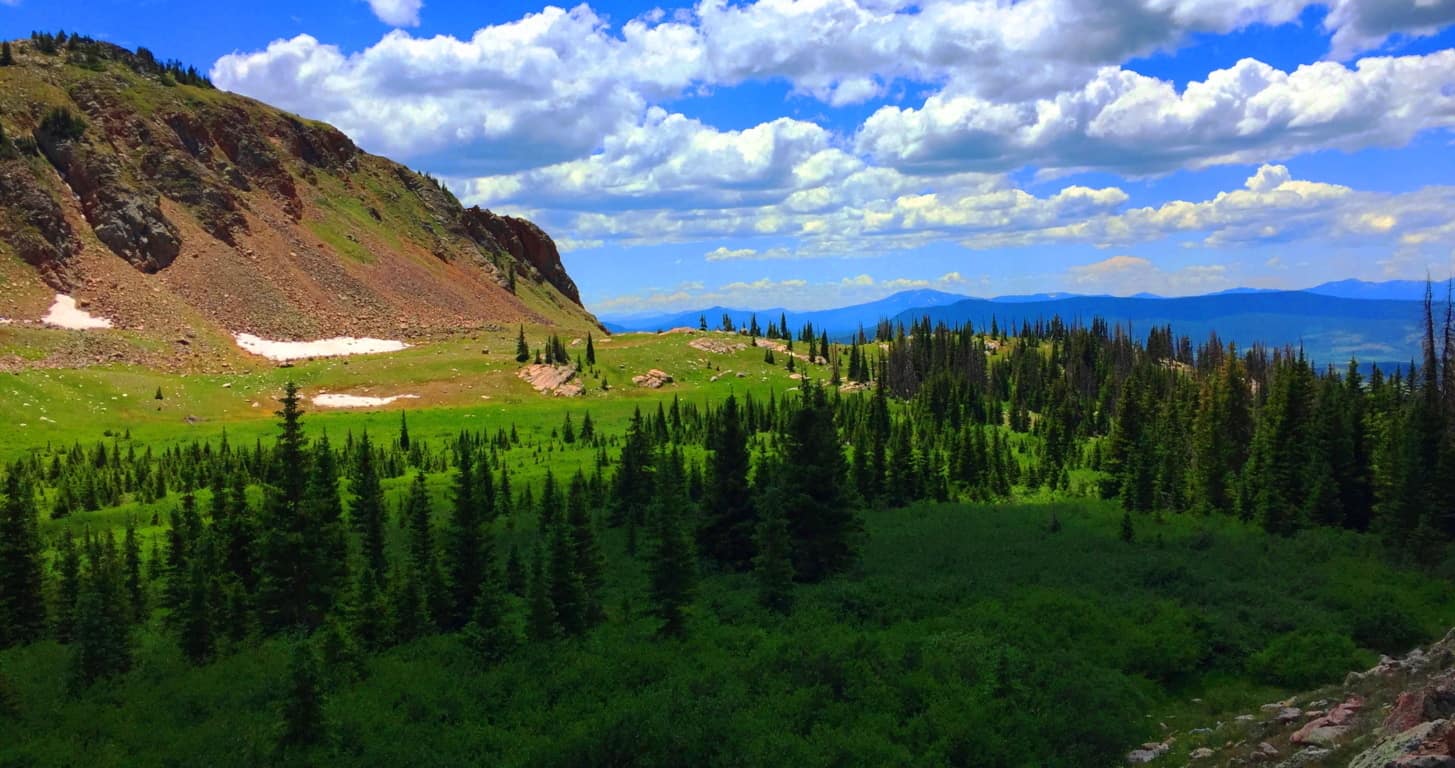
Neolithic Cultures seem to have had the capacity to recognize sites of great beauty. In many places, for example, Standing Stones and Dolmens are found facing the most gorgeous scenes of the heights they occupy. The Standing Stone of the Conwy Valley in Wales overlooks the sacred valley just north of the most revered mountain of the entire Celtic World, Mount Snowdon. (Image/Below) That’s pretty significant placement…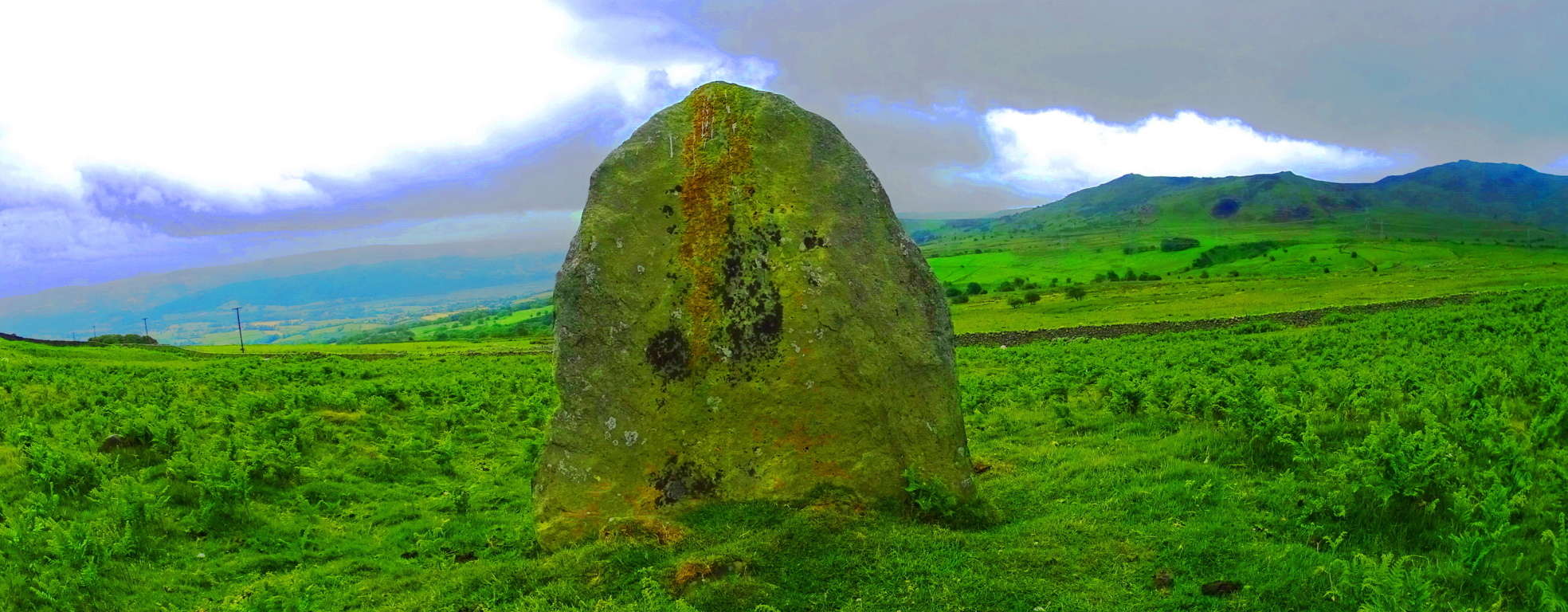 Here at Clark Peak Trail, standing distinctly above the glacial rubble is an equally significant statement, a Standing Stone that was almost certainly placed to acknowledge the incredible beauty of the valley beyond, along with the elevated basin on which it sits. This is an incredible statement of epic proportion that signals an anthropological link to the cultural practices of a Neolithic Culture a Continent, and Ocean away. To find this here was one of the most exciting moments of my life. It vindicates the idea that the heights of the world, mountain ranges in Celtic, Semitic, and Native American places, were once occupied by a Neolithic Culture that had significantly similar practices in marking-out sacred territories with megaliths. Those who dismiss America as a place void of Celtic-esque culture are slowy being dismissed as academic charlatans, theorizing from afar, never to be found in the heights where the answers are, only in the cities where the money is. This may be the worlds first international glimpse at an absolutely gorgeous American Standing Stone in the heights of the Colorado Rockies, on Clark Peak Trail, of Medicine Bow National Park. (Image/Below)
Here at Clark Peak Trail, standing distinctly above the glacial rubble is an equally significant statement, a Standing Stone that was almost certainly placed to acknowledge the incredible beauty of the valley beyond, along with the elevated basin on which it sits. This is an incredible statement of epic proportion that signals an anthropological link to the cultural practices of a Neolithic Culture a Continent, and Ocean away. To find this here was one of the most exciting moments of my life. It vindicates the idea that the heights of the world, mountain ranges in Celtic, Semitic, and Native American places, were once occupied by a Neolithic Culture that had significantly similar practices in marking-out sacred territories with megaliths. Those who dismiss America as a place void of Celtic-esque culture are slowy being dismissed as academic charlatans, theorizing from afar, never to be found in the heights where the answers are, only in the cities where the money is. This may be the worlds first international glimpse at an absolutely gorgeous American Standing Stone in the heights of the Colorado Rockies, on Clark Peak Trail, of Medicine Bow National Park. (Image/Below)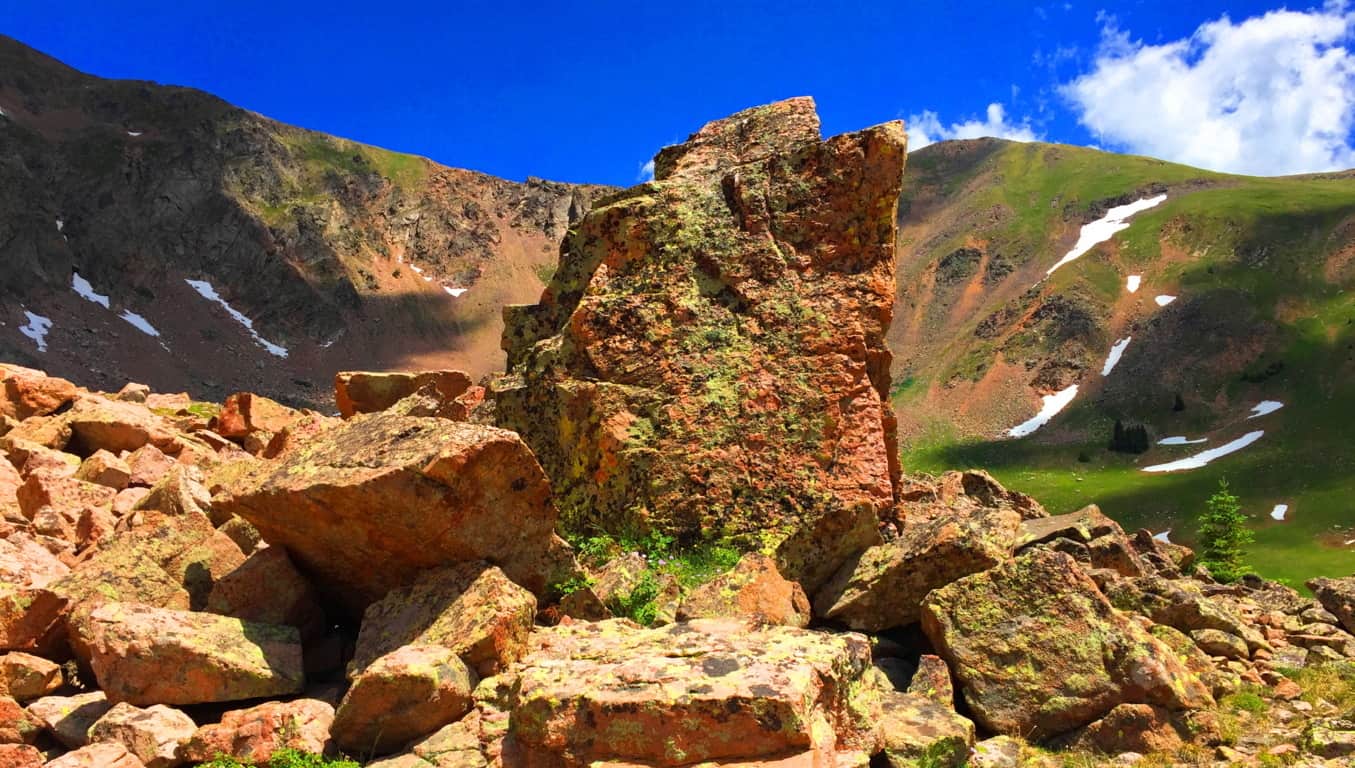
This Standing Stone is 6 feet high and 4 feet thick, looming on the left ridge just above the main Trail along the upper basin fields. The most distinct crafted cut of this Stone’ is along the entirety of Its right side. At the top of the Stone’ there is a distinctly straight top ‘cut’, with an indented ‘top’ slant above it. The left side contains two smaller ‘levelly’ crafted indents. It is so distinctly different than any of the other stones in the basin that I was left to wonder how it was possible that not one person had acknowledged it before?! Additionally, like so many Standing Stones, there is a distinctly marked Cairn on the ledge below, a fairly large crafted cavern where the designers of this Stone would’ve kept objects of value tucked-away. A set of large parallel streaks marks the stone above the trademark opening at the bottom right of the boulder. Do you see any streaks in any of the stones around the area? No, you don’t. The stone is marked for a reason, it was obviously a valued setting in the basin for whoever claimed it.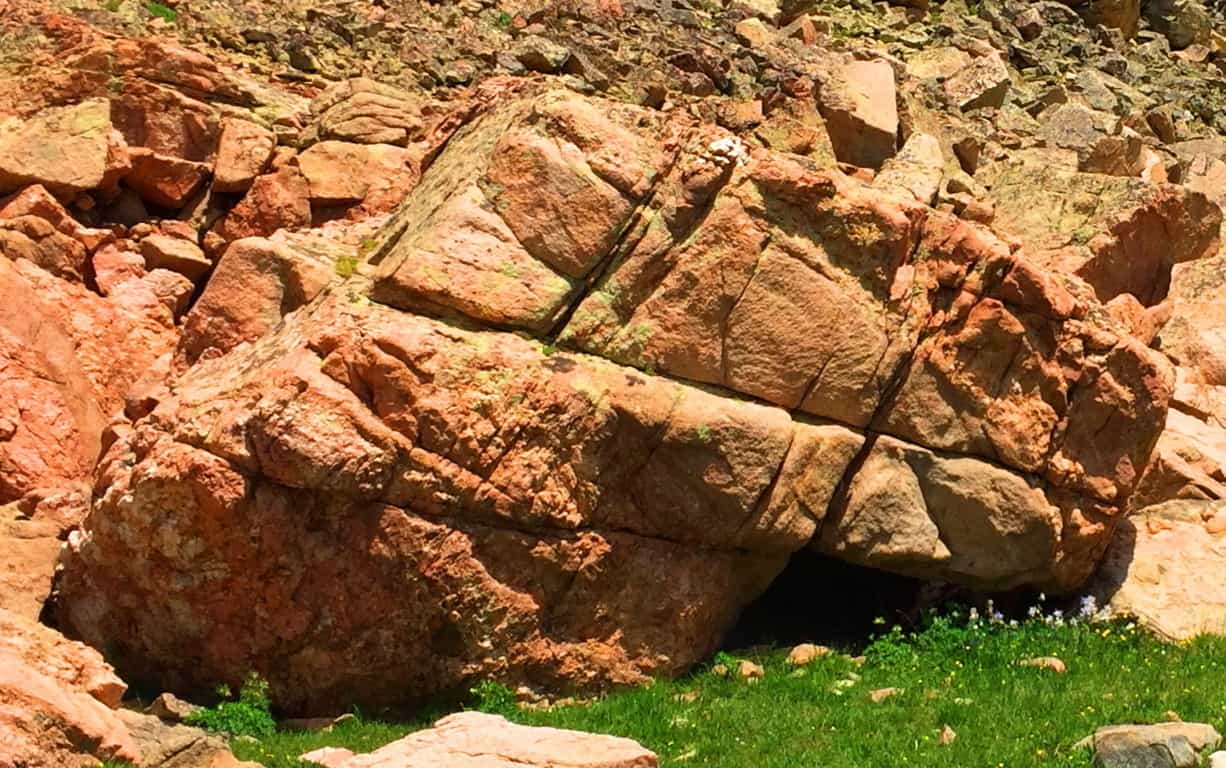 This Cairn Colorado was one of the largest I had ever seen. Other Cairns of this nature could be found in Ireland, New England and practically ever other Celtic peak. Take a look at these very similar Cairns to be found in Ireland and New England: It is true that they look very natural, but their attributes are almost always the same, containg an emblematic “side” which covers a specific gap on the right side, and are in areas where other amazing stones have been blatantly crafted. These Cairns are almost always found near sacred stone statements in the landscape, meaning they are indicative of a specific area that was inhabited by craftsman of the Neolithic Era.
This Cairn Colorado was one of the largest I had ever seen. Other Cairns of this nature could be found in Ireland, New England and practically ever other Celtic peak. Take a look at these very similar Cairns to be found in Ireland and New England: It is true that they look very natural, but their attributes are almost always the same, containg an emblematic “side” which covers a specific gap on the right side, and are in areas where other amazing stones have been blatantly crafted. These Cairns are almost always found near sacred stone statements in the landscape, meaning they are indicative of a specific area that was inhabited by craftsman of the Neolithic Era.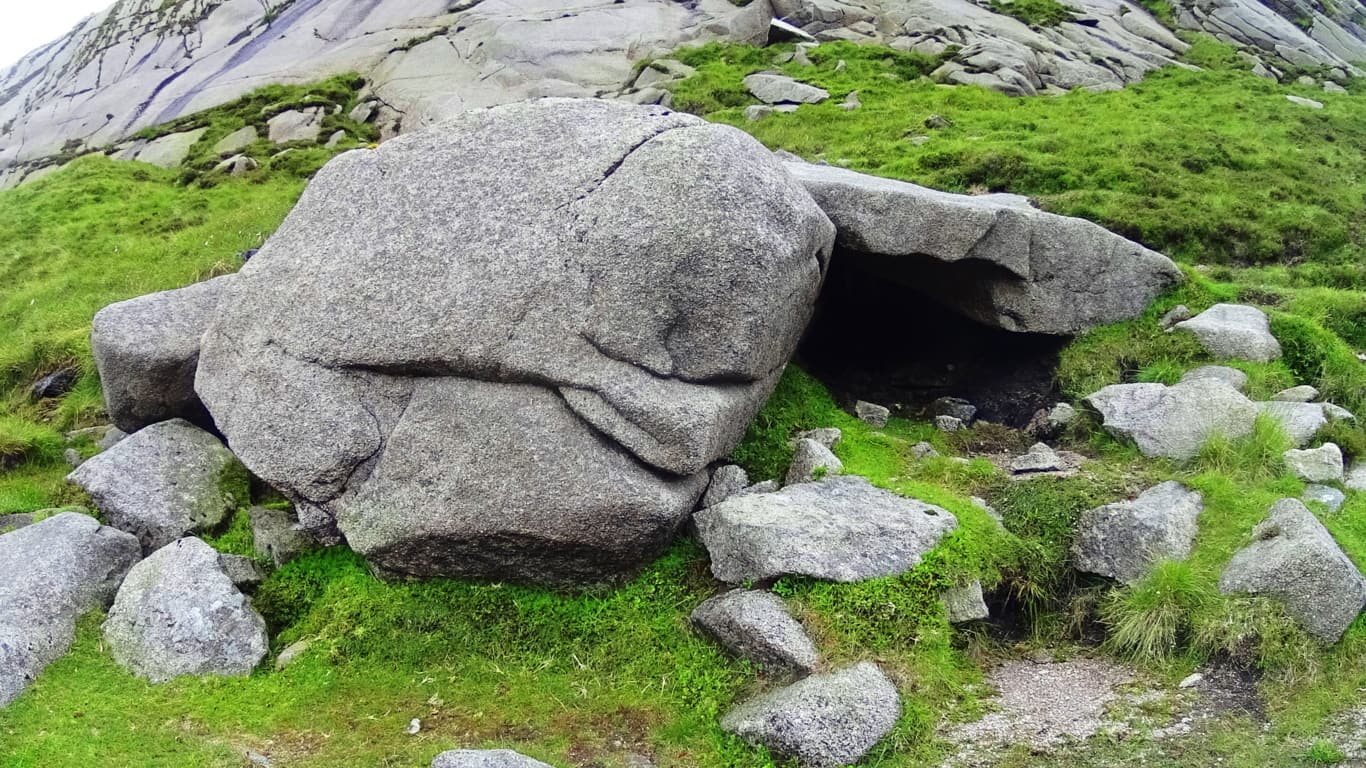
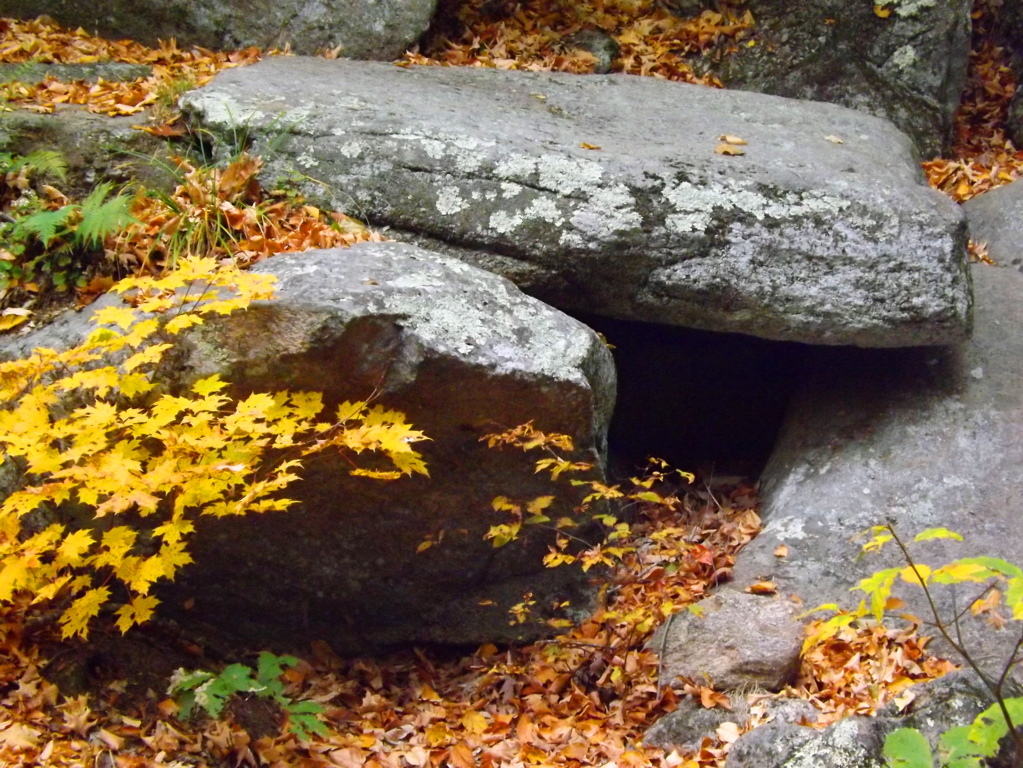
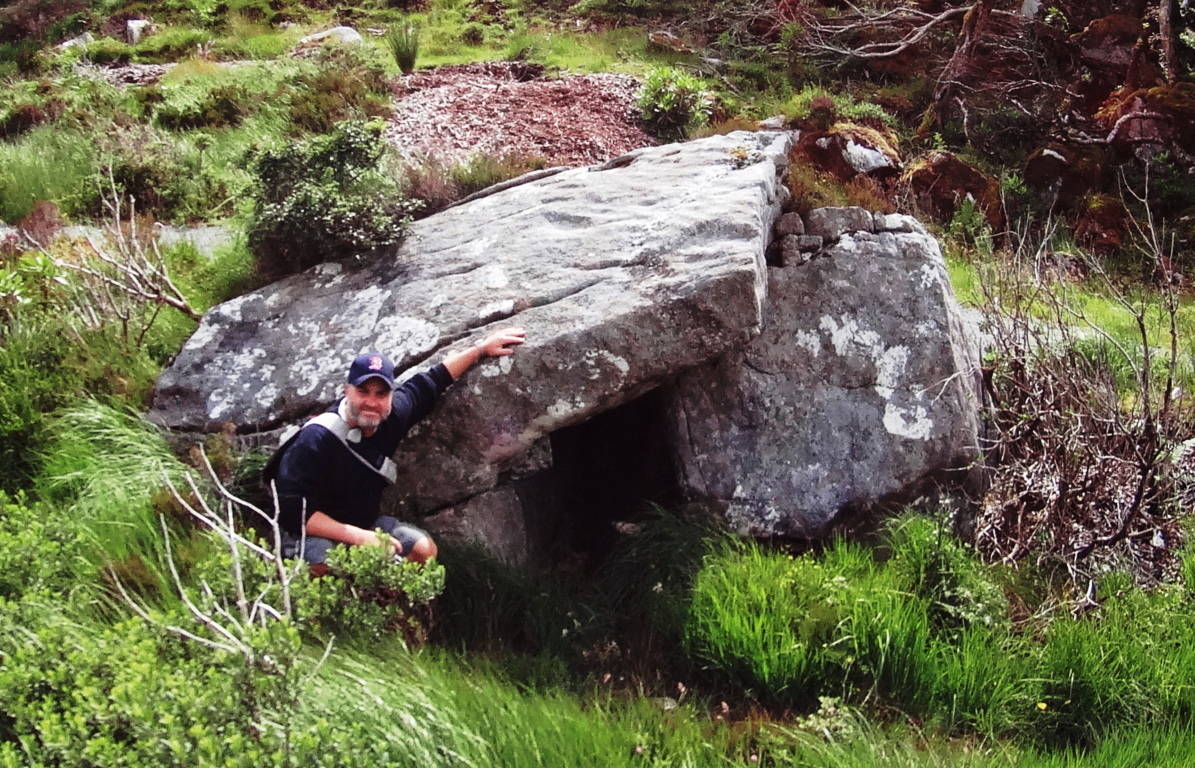 From the Standing Stone here in Colorado, the last portion of the Trail runs up the Basin. Tucked into the Basin is a lovely hidden lake, which at one time would’ve been a perfect source of drinking water for anyone trying to occupy these heights. All the elements for survival are there. Make your way up the final narrow pathway, where beneath a ledge of millions of stones, none of which look anything like the ones that we have identified as ‘crafted’, sits the stellar pool. Here is the final elevated path into the high basin the image below:
From the Standing Stone here in Colorado, the last portion of the Trail runs up the Basin. Tucked into the Basin is a lovely hidden lake, which at one time would’ve been a perfect source of drinking water for anyone trying to occupy these heights. All the elements for survival are there. Make your way up the final narrow pathway, where beneath a ledge of millions of stones, none of which look anything like the ones that we have identified as ‘crafted’, sits the stellar pool. Here is the final elevated path into the high basin the image below: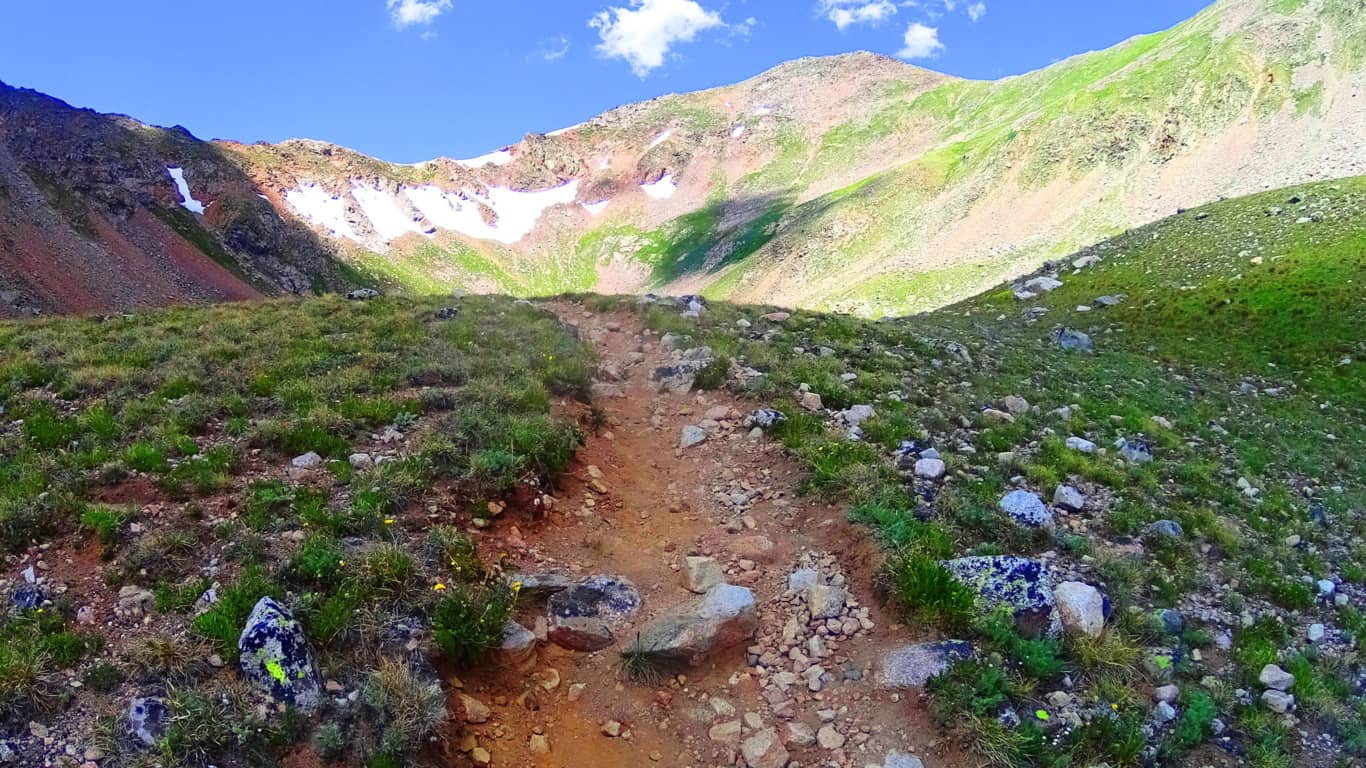 And here is the reflective pool. Imagine looking down on this pool on a clear night to look at the stars! It may very well be that the Standing Stone is pointing to a specific constellation in the night sky, or some meaningful designation of that nature. It would require more time than I had on this fine day to discover such things. But it is truly safe to say that most Standing Stones have a multi-contextual meaning, and here in Colorado, with a crystalline clear sky in July, that possibility is very real.
And here is the reflective pool. Imagine looking down on this pool on a clear night to look at the stars! It may very well be that the Standing Stone is pointing to a specific constellation in the night sky, or some meaningful designation of that nature. It would require more time than I had on this fine day to discover such things. But it is truly safe to say that most Standing Stones have a multi-contextual meaning, and here in Colorado, with a crystalline clear sky in July, that possibility is very real. 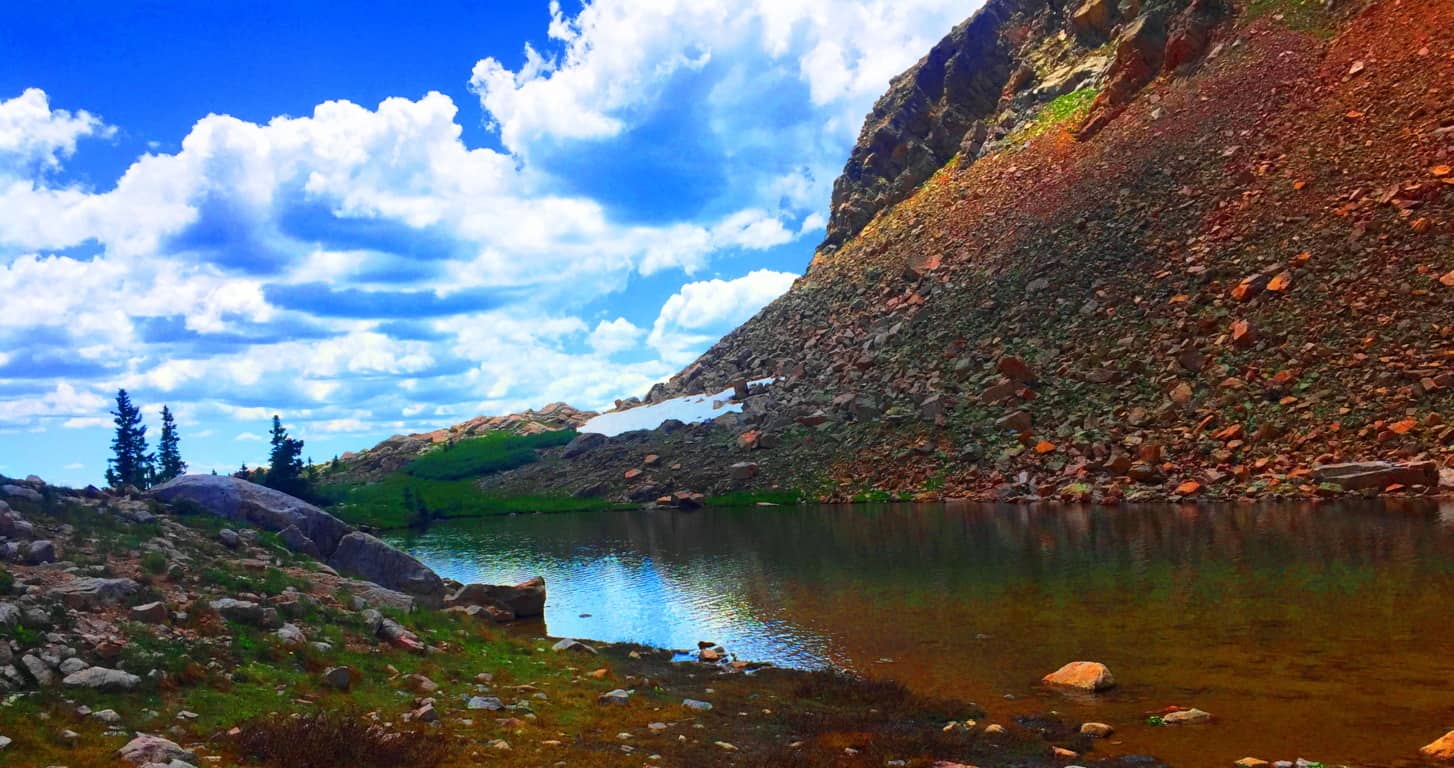
This is one of the highest basins in Colorado, and the country. Like so many beautiful Celtic trails, things here slowly blend into child-like wonder. You are humbled. A look back from the Lake displays a gorgeous jade animation of the entire basin, with the High Plain of the Rocky Mountains beyond, along with drifting clouds that practically touch the upper crags. There is a very real temptation to break all convention and remain in this place, however reclusive it may sound. If a Neolithic individual did decide to live here, the set up for a fantastic existence seems perfectly clear; you could keep a flock in the lower basin, keep a fire by the upper lake, drink a never ending supply of water, and monitor the entire scene from the Standing Stone vantage. Logically it makes sense here.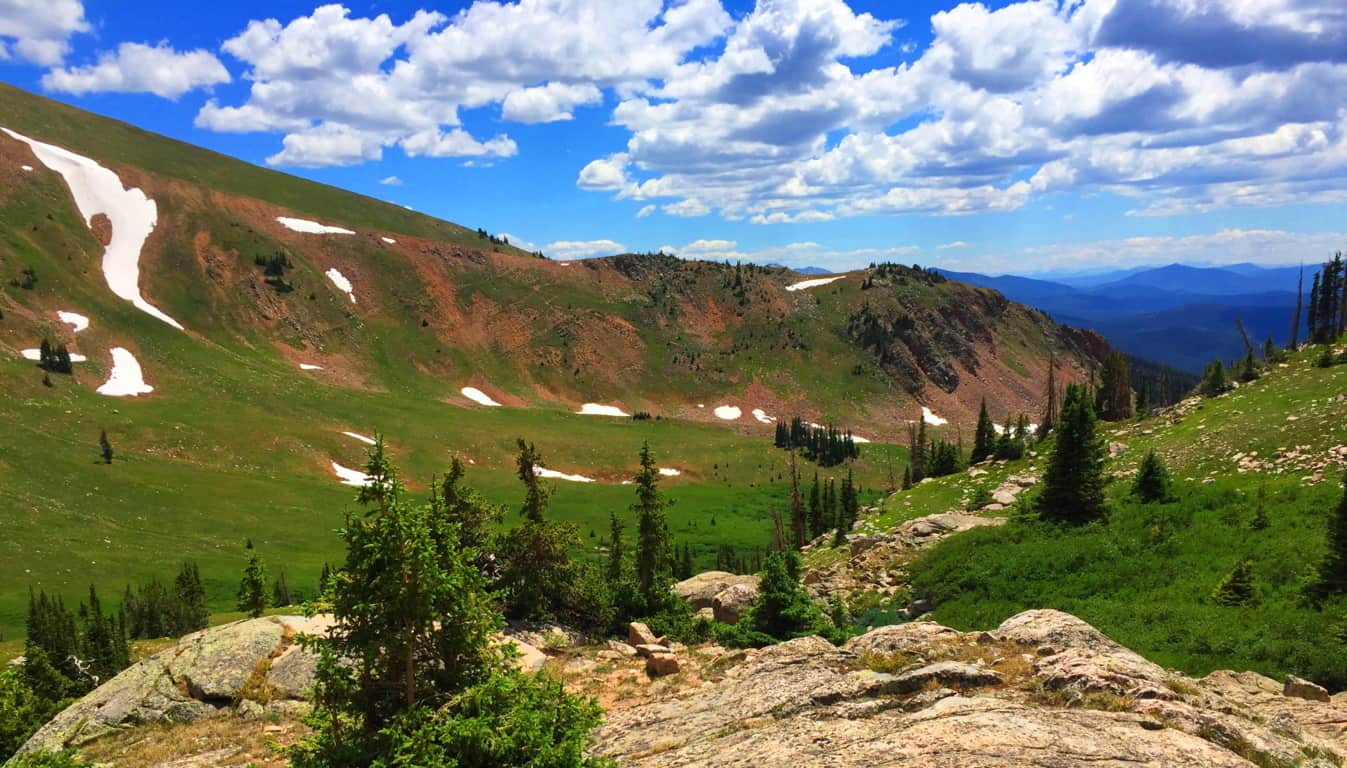 As someone who was trying to scale the heights of Glen Coe Scotland while caught in a rain storm exactly one year earlier, I could not help but feel that Clark Peak Colorado is one of the most comfortable challenges you will ever engage in the month of July. The air temperature and quality in near perfect, pristine, and so delightful. The wildflowers exude an overwhelming spectrum of statements, where entire mountain glens are covered in violet, steel-blue, glowing wild yellow, and subtle bits of auburn.(Image/Below)
As someone who was trying to scale the heights of Glen Coe Scotland while caught in a rain storm exactly one year earlier, I could not help but feel that Clark Peak Colorado is one of the most comfortable challenges you will ever engage in the month of July. The air temperature and quality in near perfect, pristine, and so delightful. The wildflowers exude an overwhelming spectrum of statements, where entire mountain glens are covered in violet, steel-blue, glowing wild yellow, and subtle bits of auburn.(Image/Below)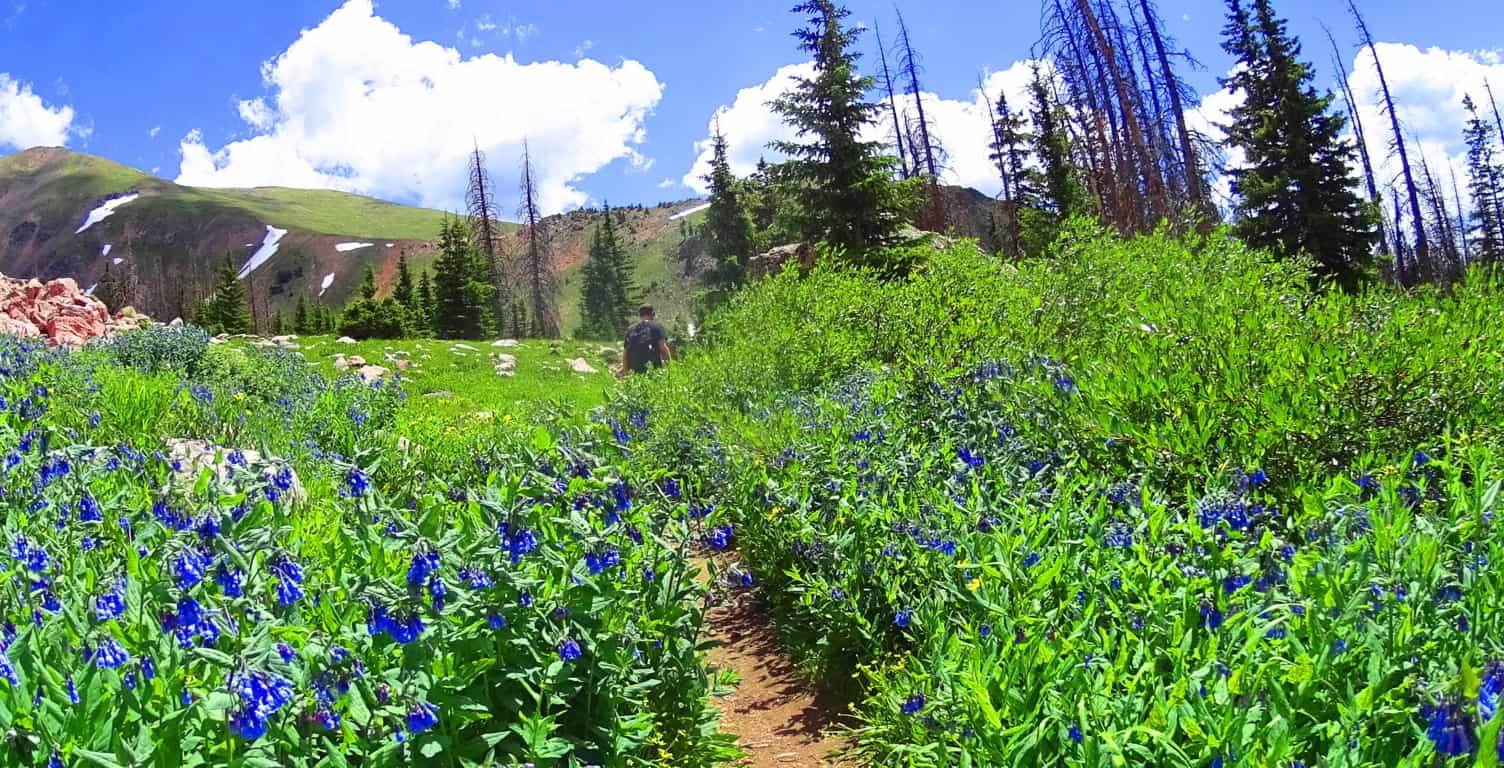 It is understandable if readers are still not sold on the idea of a Neolithic Culture in the heights of these mountains. To some people they might see a mere stone where there is an actual cultural statement. It has taken six years of challenging research in some of the most off-the-grid locations on earth to finally begin to see the patterns of a very real Neolithic Culture. Only after dozens of expeditions have the specific memes begun to reveal themselves. It is not just the evidence itself, but the context of the evidence: the position of a stone in a particular way in a valley; the paring of stone statements in not just one valley, but dozens. There is a very real consistency. It is hard to tell if the Standing Stone here at Clark Peak was there before the rockslide, and was later engulfed by the rush of stone, or if it was placed squarely into the stones after the fact? But the most important, and truly obvious thing, is that there is no other stone even remotely like it in the entire basin, which is what I mean by context. And moreover, the place where it stands, like so many other Standing Stones across the world, is most likely the most advantageous, as well as beautiful, vantage on the entire valley; it’s as if someone wanted to claim the best of what the valley had to offer. I’ve seen this in literally dozens of mountain ranges. The overall point is that hiking and ‘striding’ will take YOU there. You can go and size up the strangeness of these megaliths for YOURSELF. You don’t need my opinion, you can get there and judge on your own! When you do I believe the realness of these statement will hit you….will make it real.
It is understandable if readers are still not sold on the idea of a Neolithic Culture in the heights of these mountains. To some people they might see a mere stone where there is an actual cultural statement. It has taken six years of challenging research in some of the most off-the-grid locations on earth to finally begin to see the patterns of a very real Neolithic Culture. Only after dozens of expeditions have the specific memes begun to reveal themselves. It is not just the evidence itself, but the context of the evidence: the position of a stone in a particular way in a valley; the paring of stone statements in not just one valley, but dozens. There is a very real consistency. It is hard to tell if the Standing Stone here at Clark Peak was there before the rockslide, and was later engulfed by the rush of stone, or if it was placed squarely into the stones after the fact? But the most important, and truly obvious thing, is that there is no other stone even remotely like it in the entire basin, which is what I mean by context. And moreover, the place where it stands, like so many other Standing Stones across the world, is most likely the most advantageous, as well as beautiful, vantage on the entire valley; it’s as if someone wanted to claim the best of what the valley had to offer. I’ve seen this in literally dozens of mountain ranges. The overall point is that hiking and ‘striding’ will take YOU there. You can go and size up the strangeness of these megaliths for YOURSELF. You don’t need my opinion, you can get there and judge on your own! When you do I believe the realness of these statement will hit you….will make it real.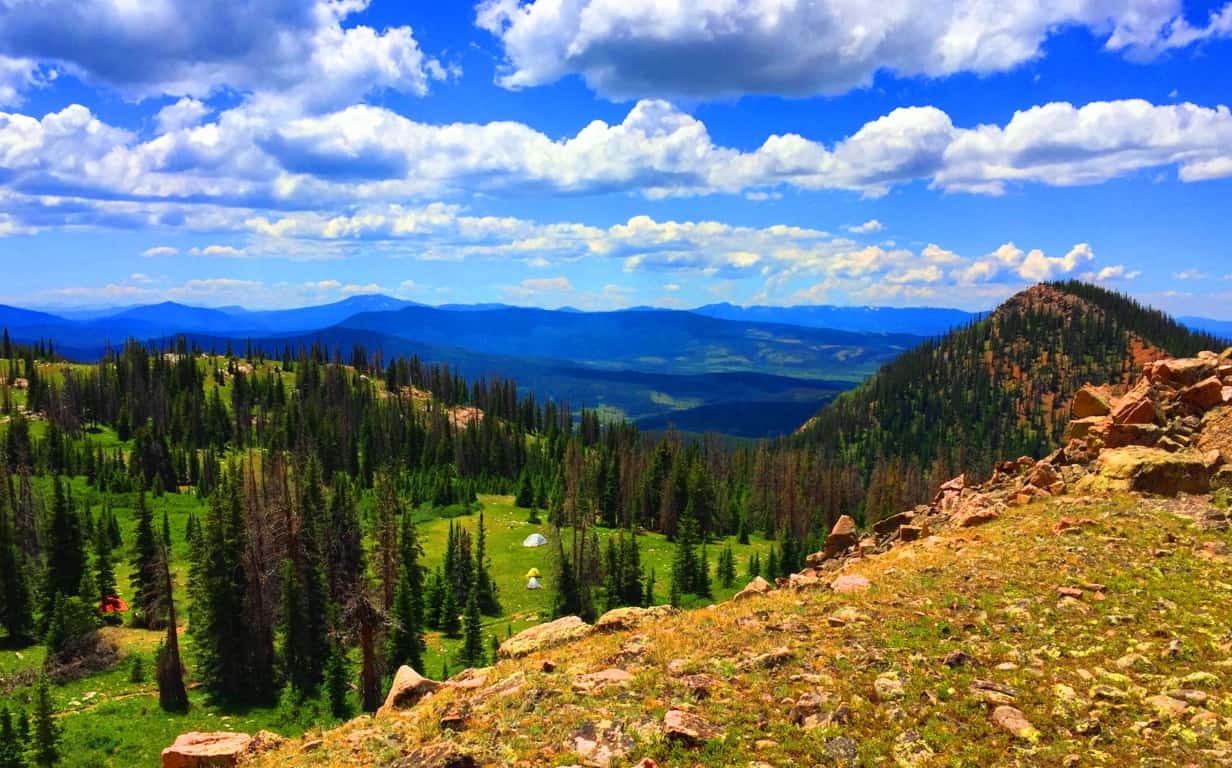 Clark Peak, from the second level trail-head, is one of the single most relaxing and cool hikes in the entire world.The reward in this place far outweighs the work, which is not usually the case for international hiking. Aside from the evidence, there is also that feeling of total tranquility in the Colorado heights, a feeling in all honesty, I have only felt once before in my life, ironically, by the Standing Stone in Wales, at the top of the gorgeous Conwy Valley. At Conwy, a Standing Stone and a Cairn both sit atop the heights, just like in this gorgeous basin in Colorado, paired together like a chair and table, but in an ancient-stone kind of way. So… plan a week or so at the cottages of the tiny American hamlet of Walden Colorado. Take the time to do what it takes to get to the trailheads for Clark Peak, which sits at the eastern edge of Medicine Bow National Park, one of the most scintillated and stellar National Parks on Earth. Find your way, and the way, amazingly, will find you. Go strong. A special thanks to my great friend and confidant Christopher Frohlich for providing his style, skill, and understanding of the grand Colorado landscape. Couldn’t have done this without you Fro’, thank you.
Clark Peak, from the second level trail-head, is one of the single most relaxing and cool hikes in the entire world.The reward in this place far outweighs the work, which is not usually the case for international hiking. Aside from the evidence, there is also that feeling of total tranquility in the Colorado heights, a feeling in all honesty, I have only felt once before in my life, ironically, by the Standing Stone in Wales, at the top of the gorgeous Conwy Valley. At Conwy, a Standing Stone and a Cairn both sit atop the heights, just like in this gorgeous basin in Colorado, paired together like a chair and table, but in an ancient-stone kind of way. So… plan a week or so at the cottages of the tiny American hamlet of Walden Colorado. Take the time to do what it takes to get to the trailheads for Clark Peak, which sits at the eastern edge of Medicine Bow National Park, one of the most scintillated and stellar National Parks on Earth. Find your way, and the way, amazingly, will find you. Go strong. A special thanks to my great friend and confidant Christopher Frohlich for providing his style, skill, and understanding of the grand Colorado landscape. Couldn’t have done this without you Fro’, thank you.